
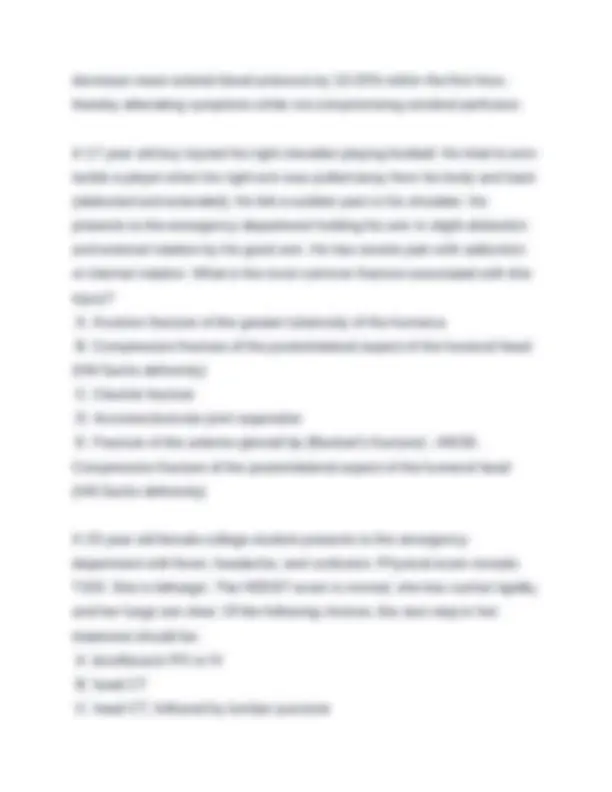
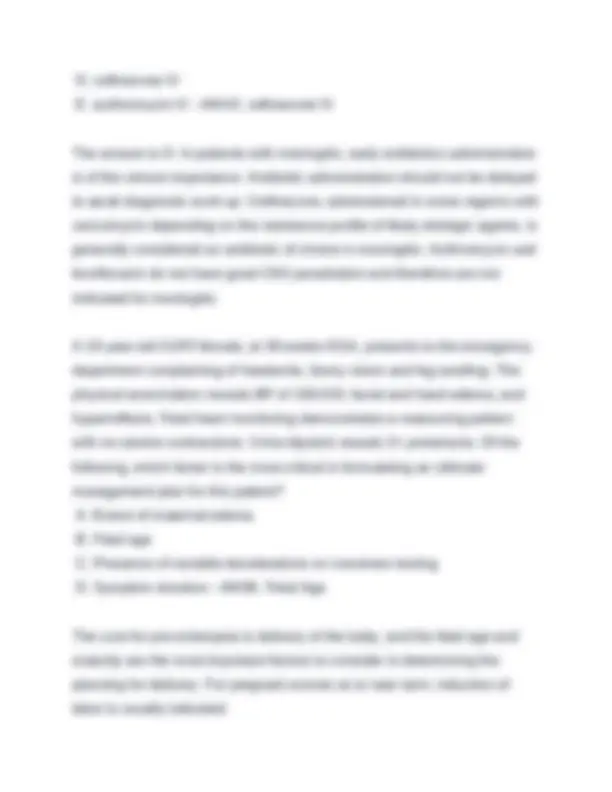

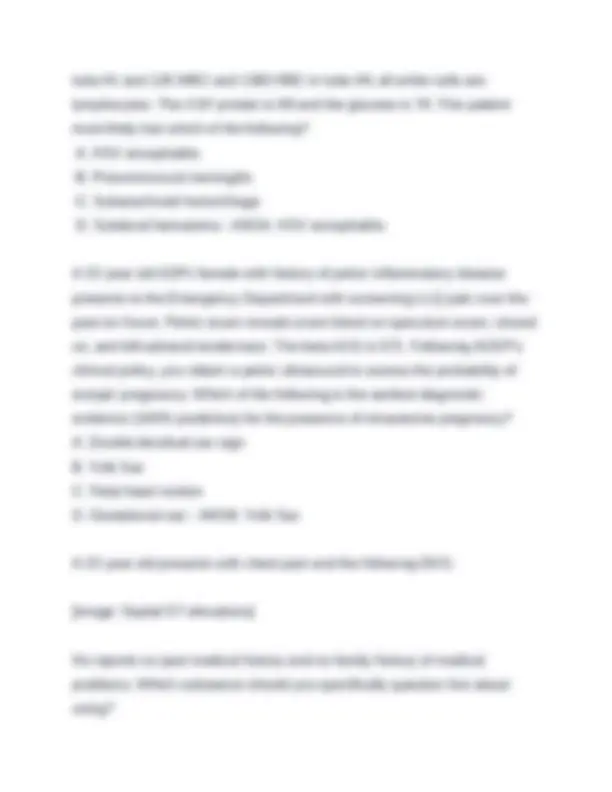
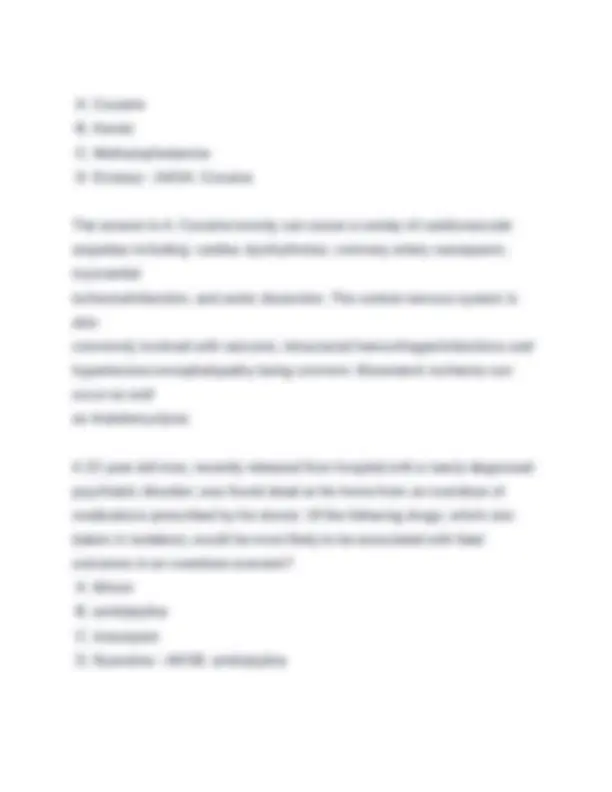
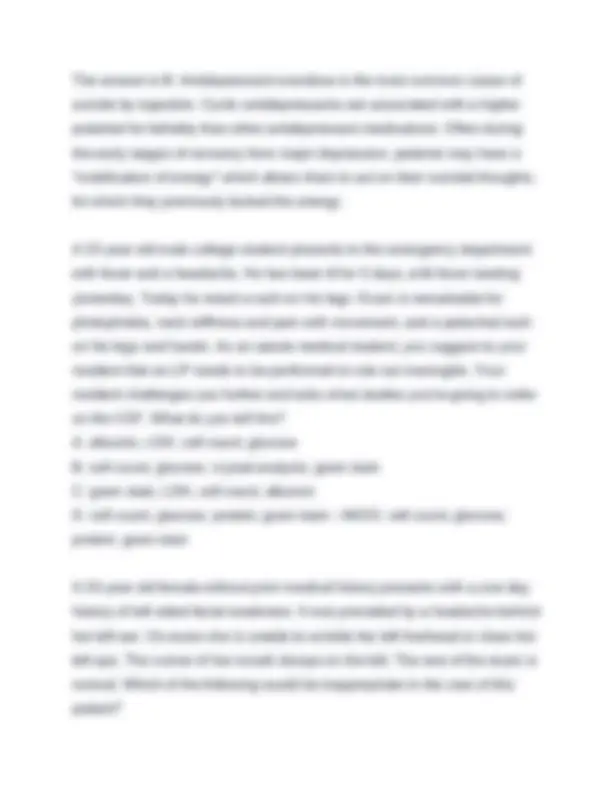
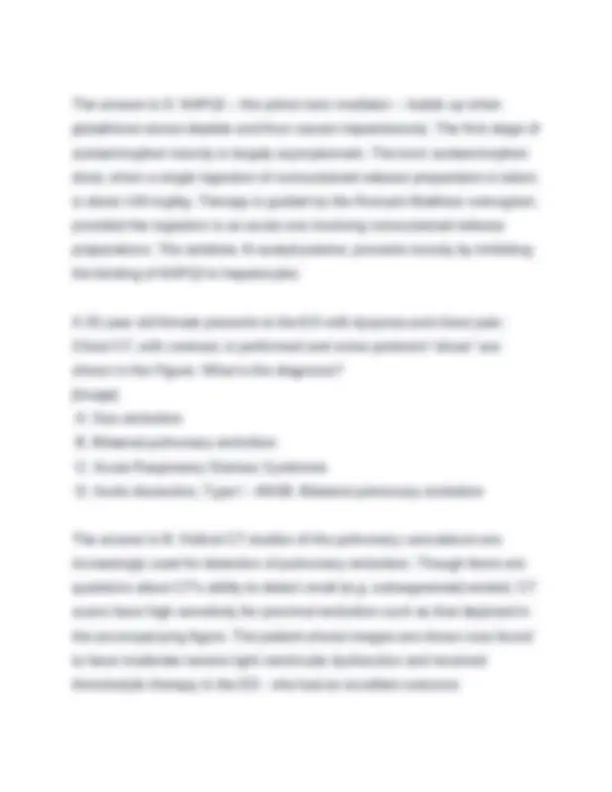
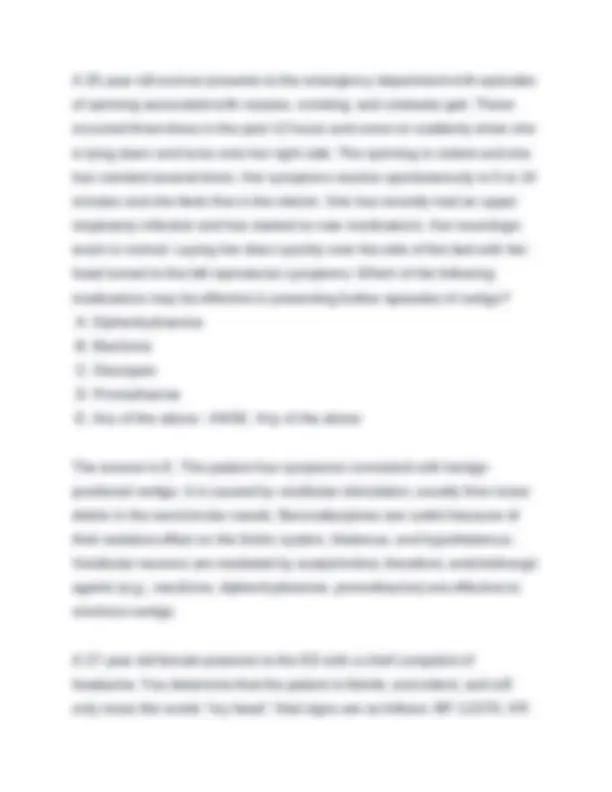
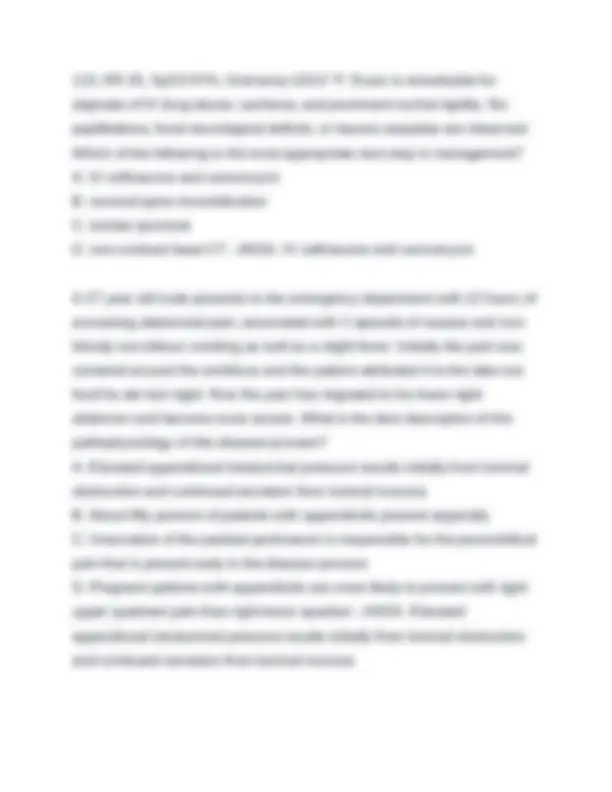
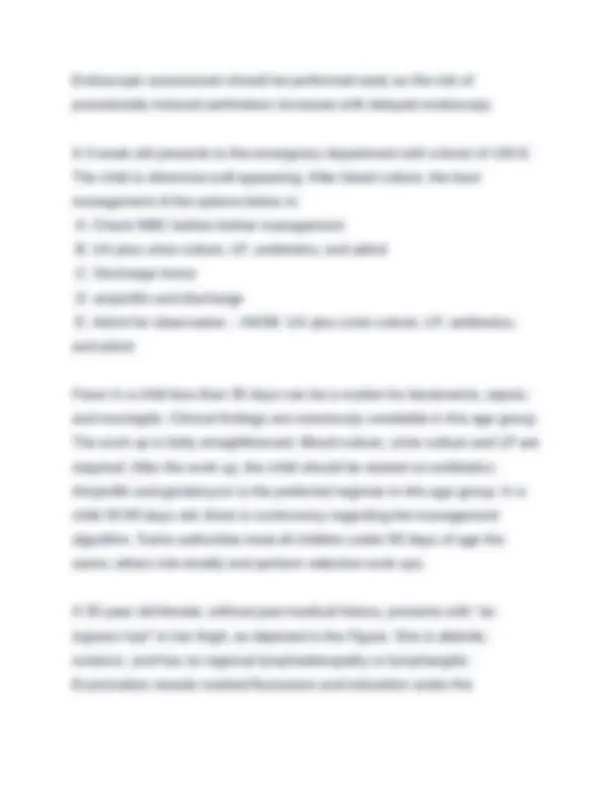
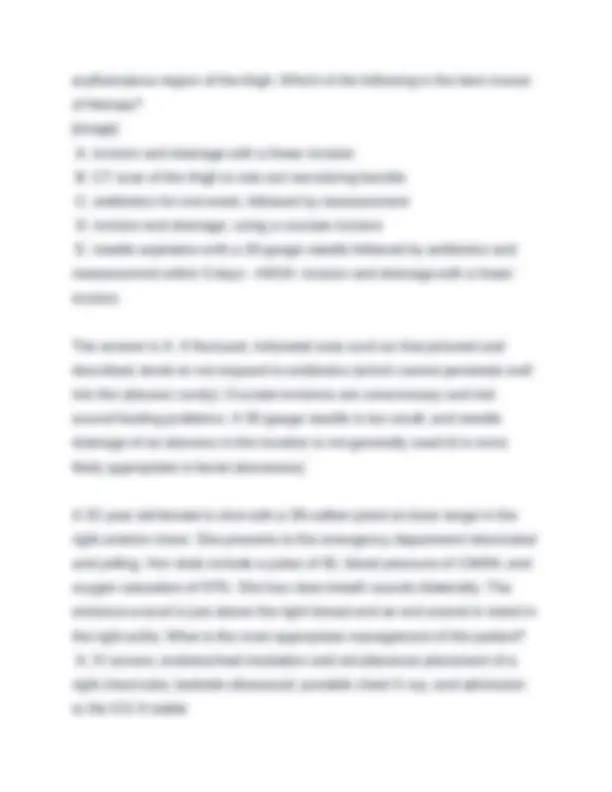
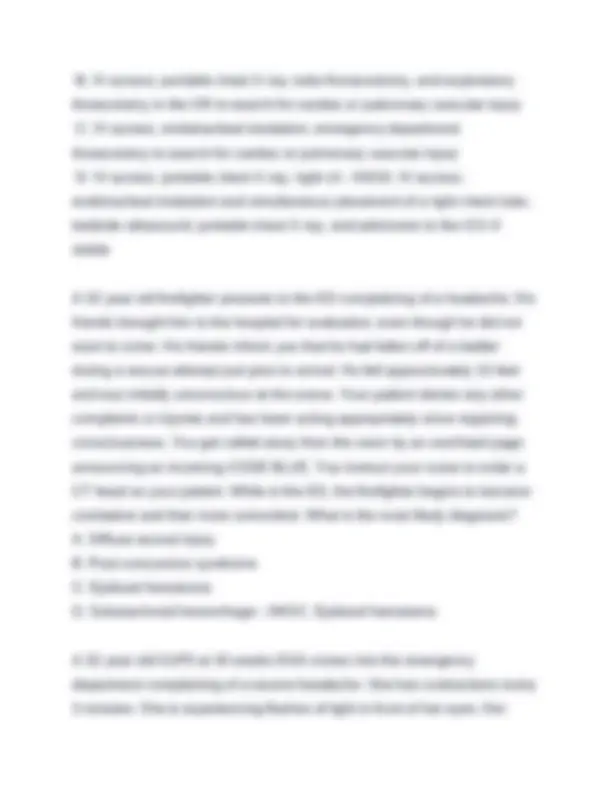
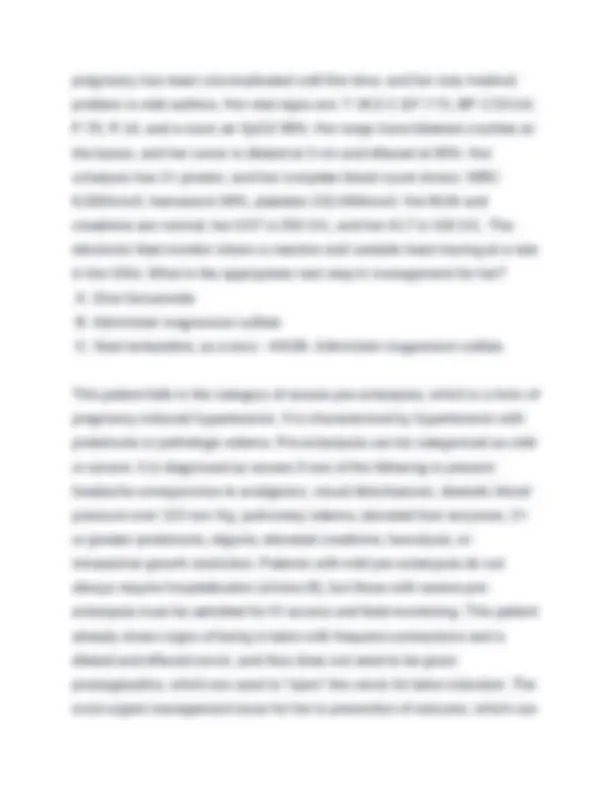
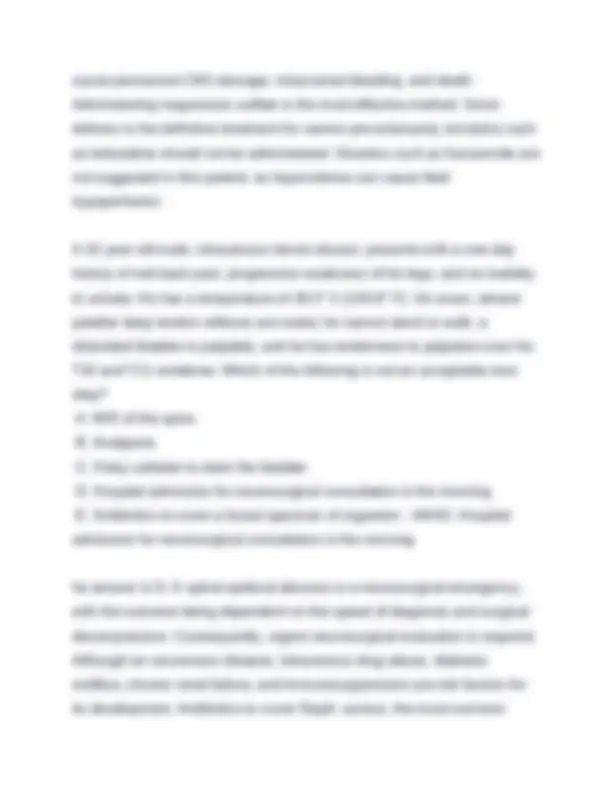
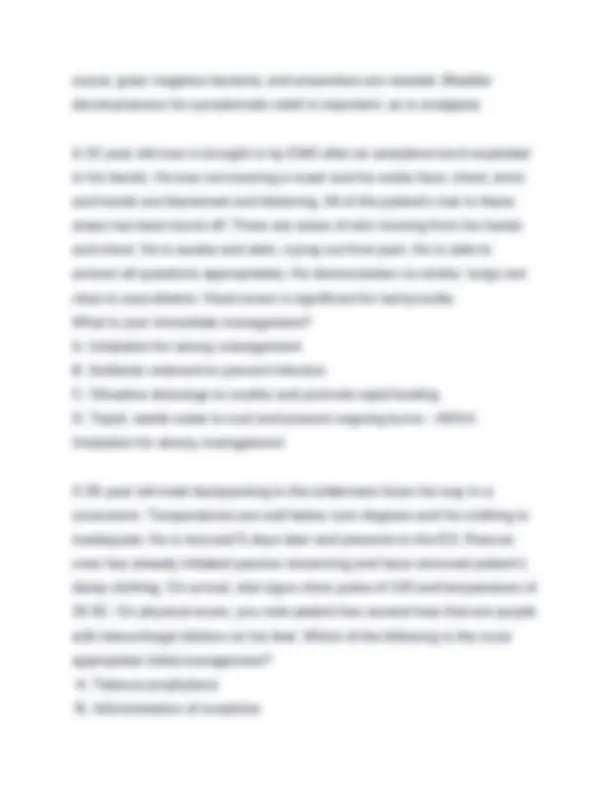
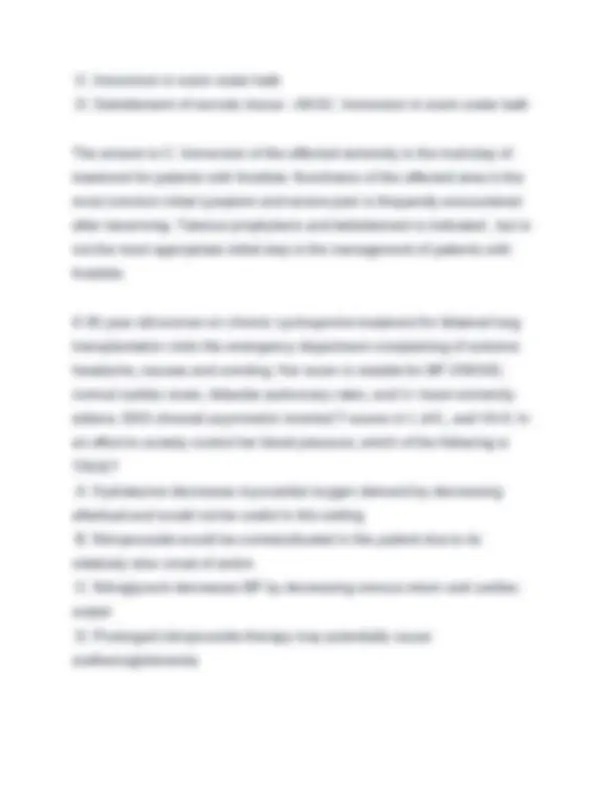
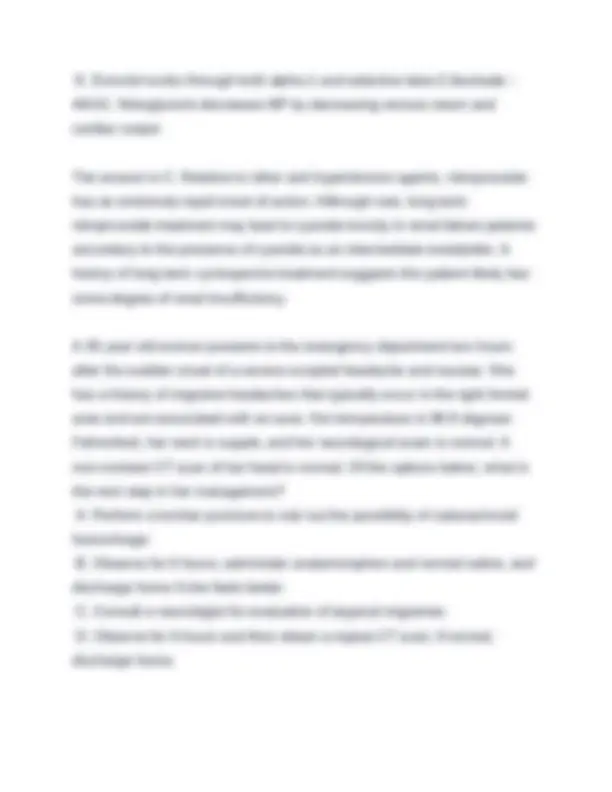
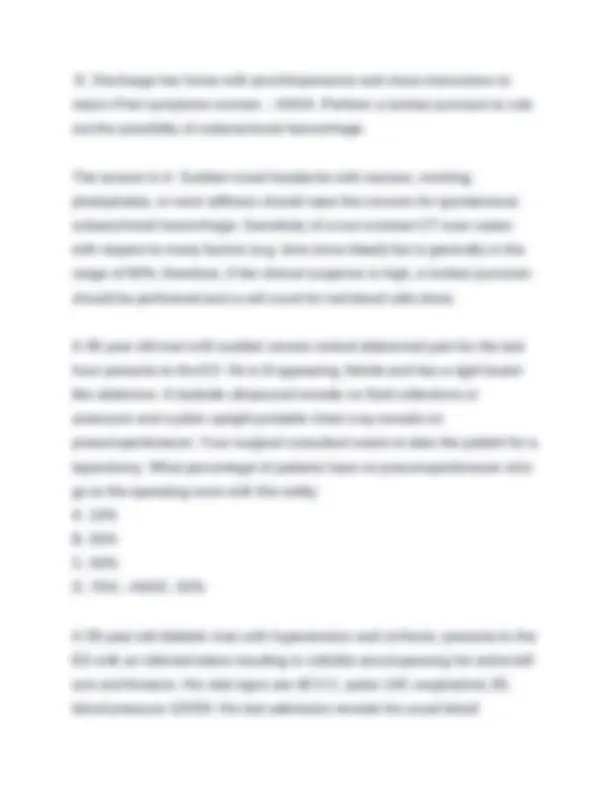
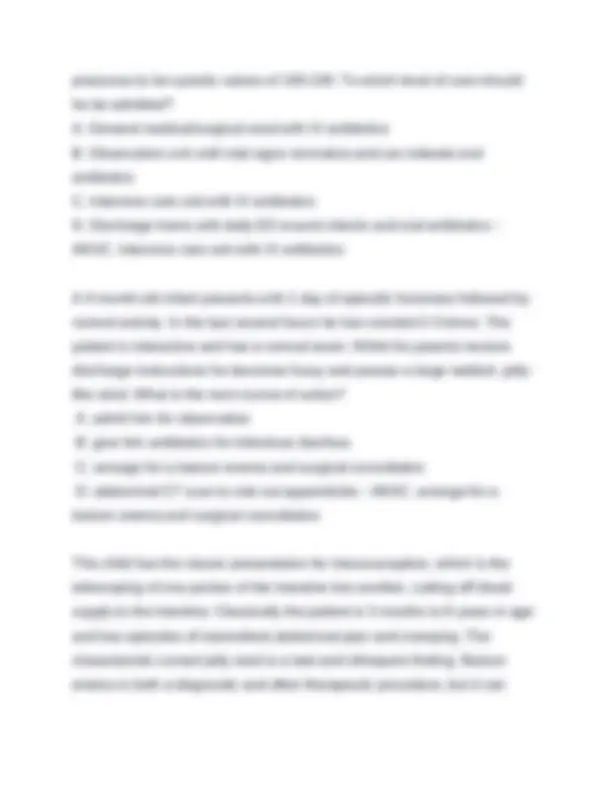
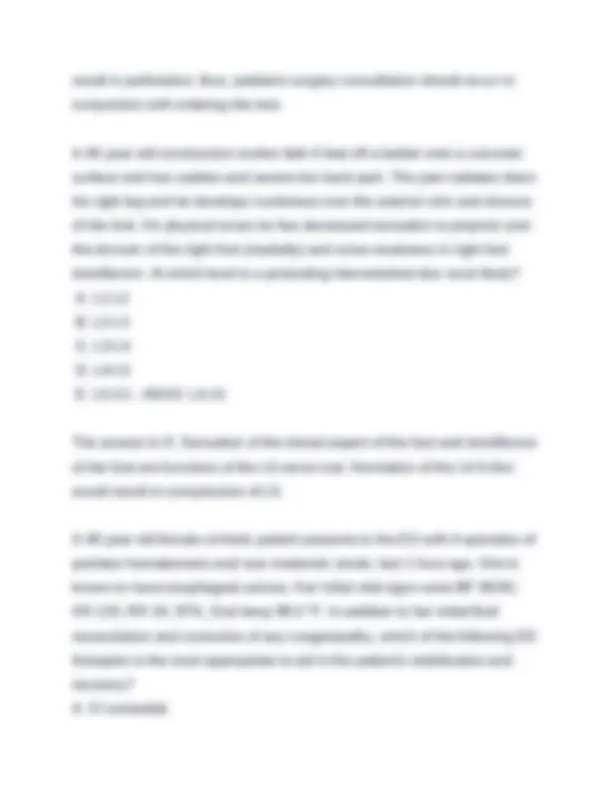
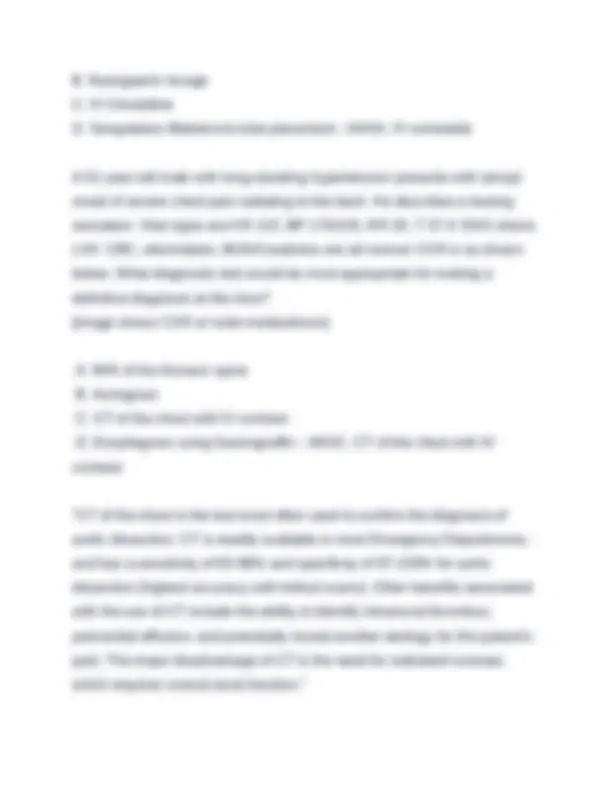
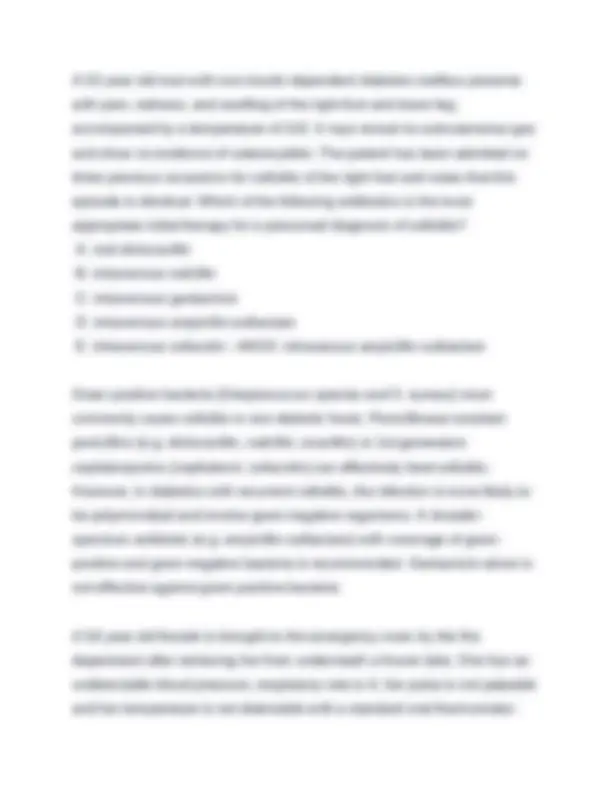
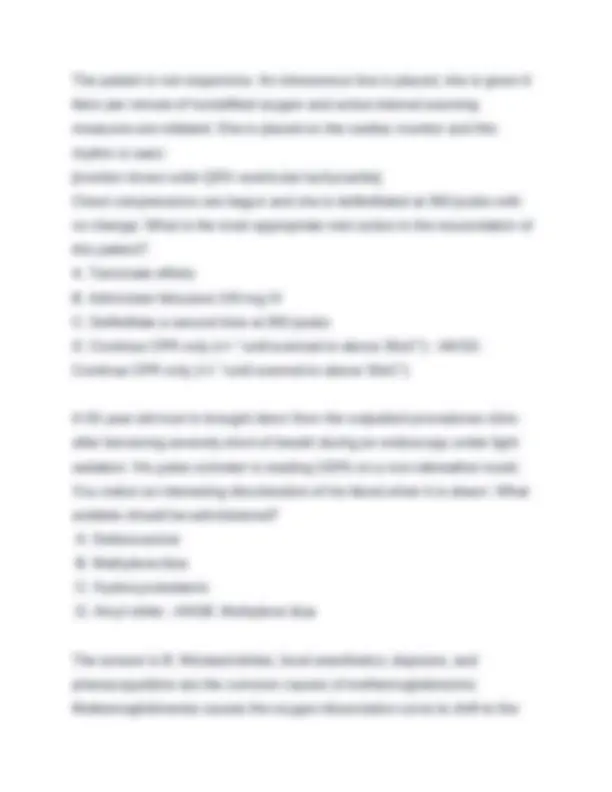
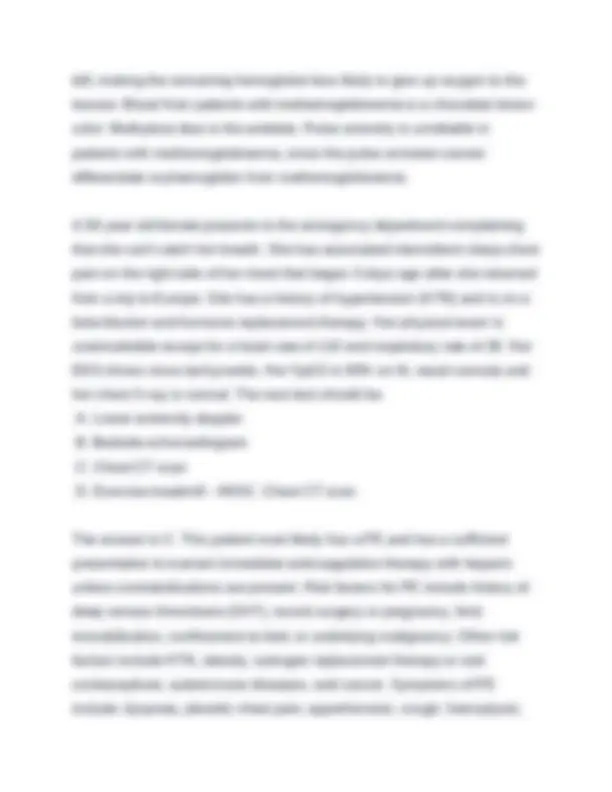
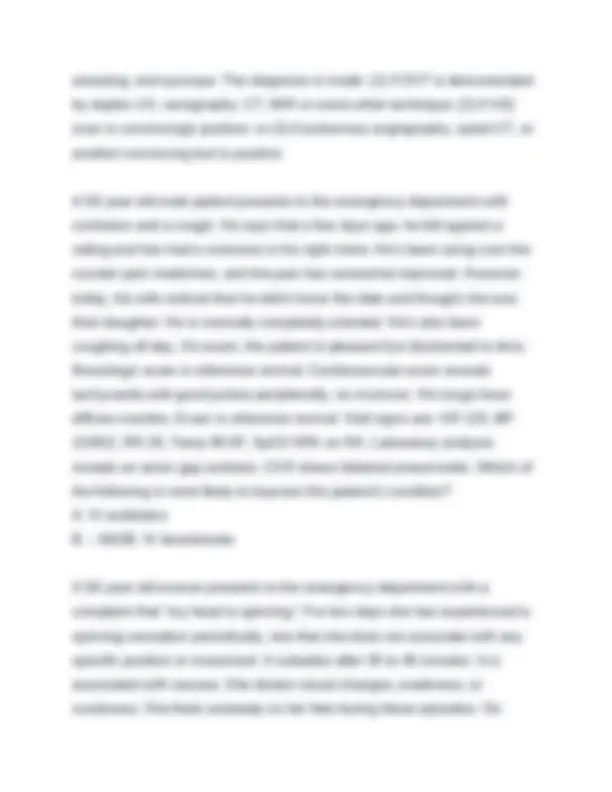
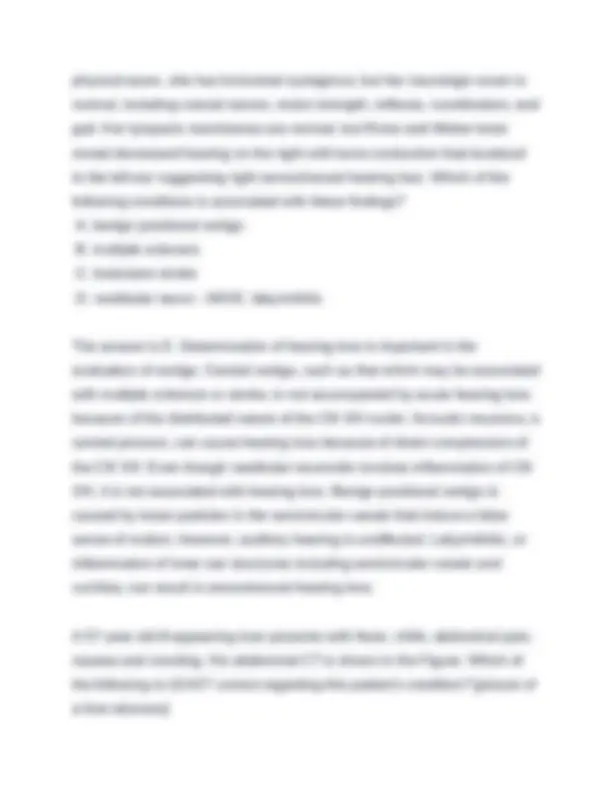
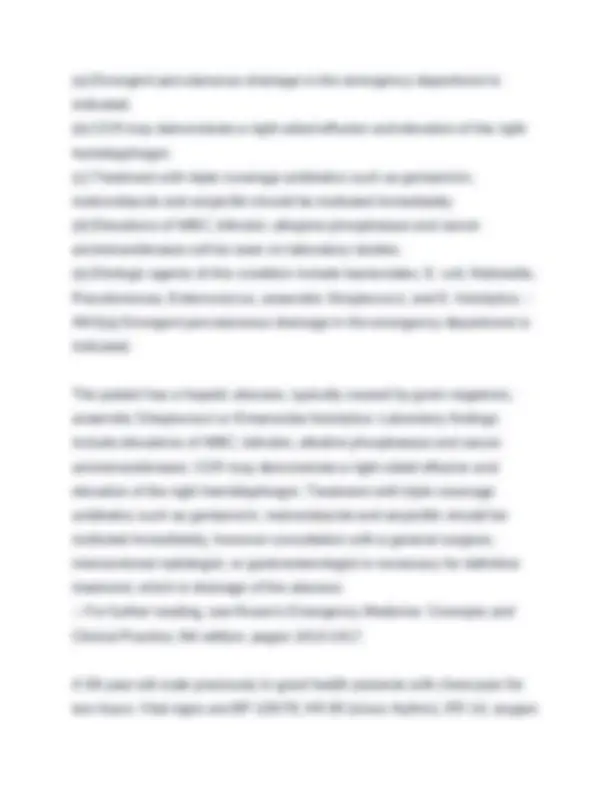
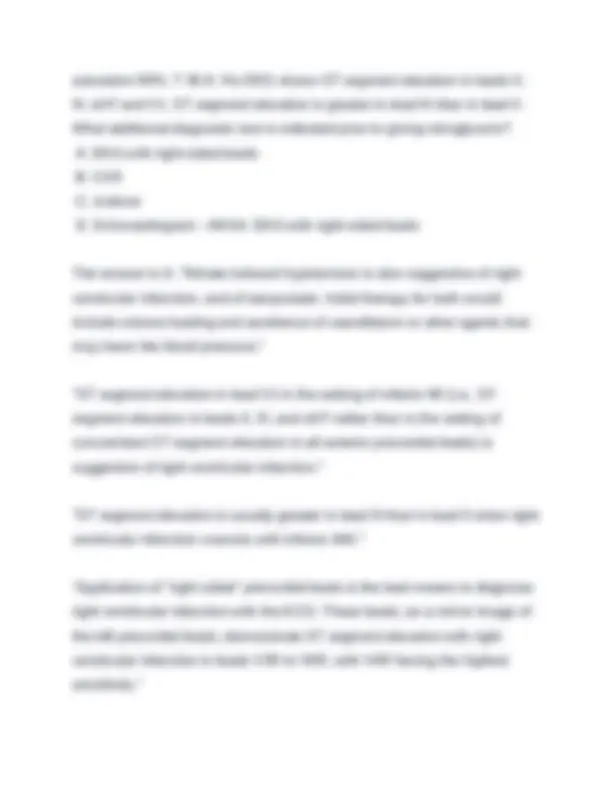
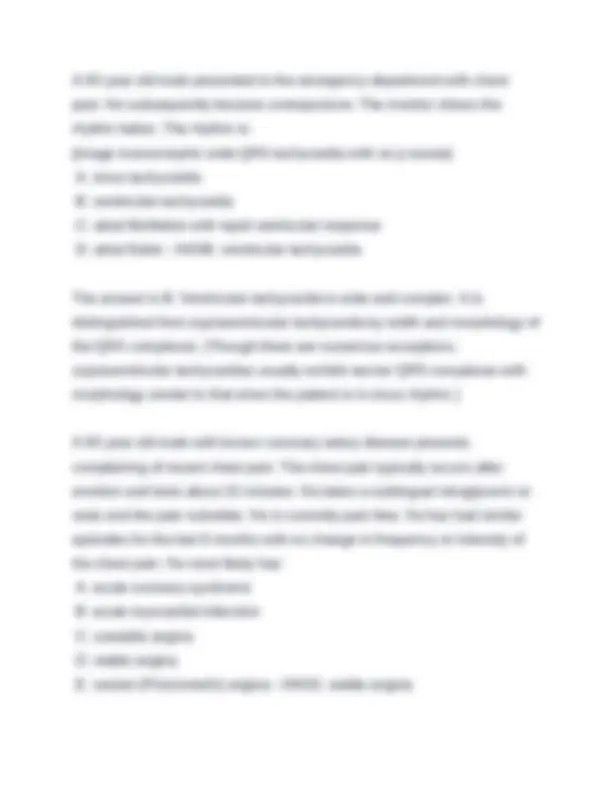
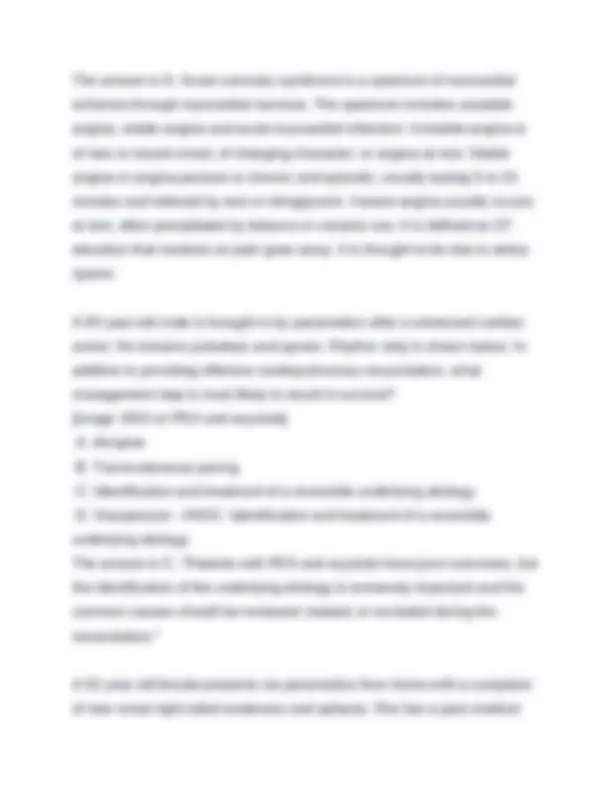
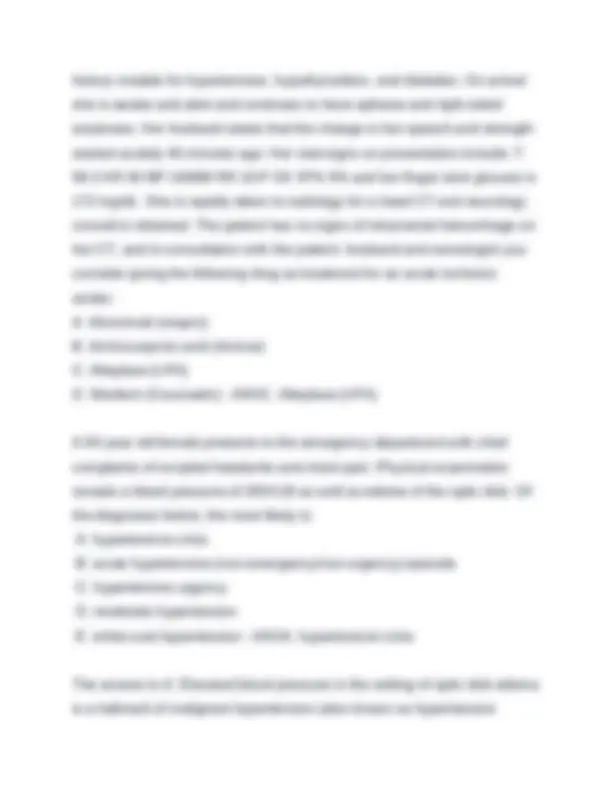
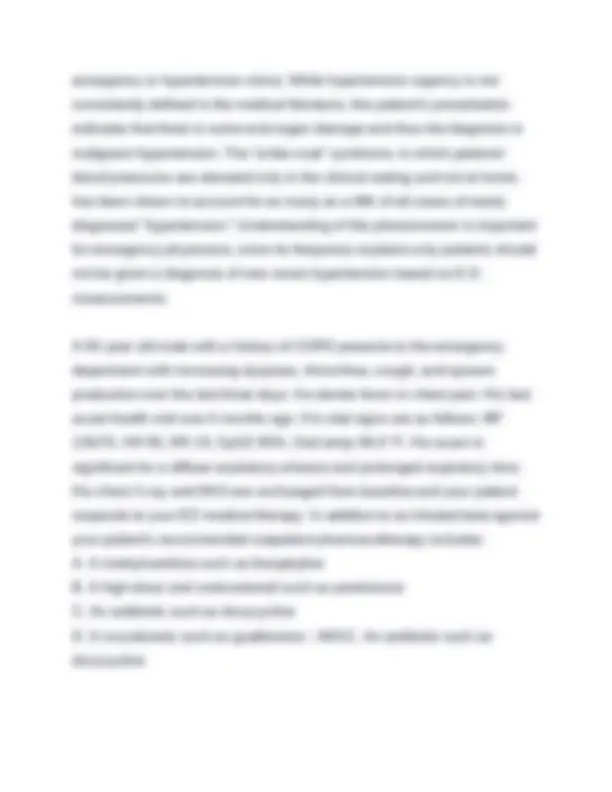
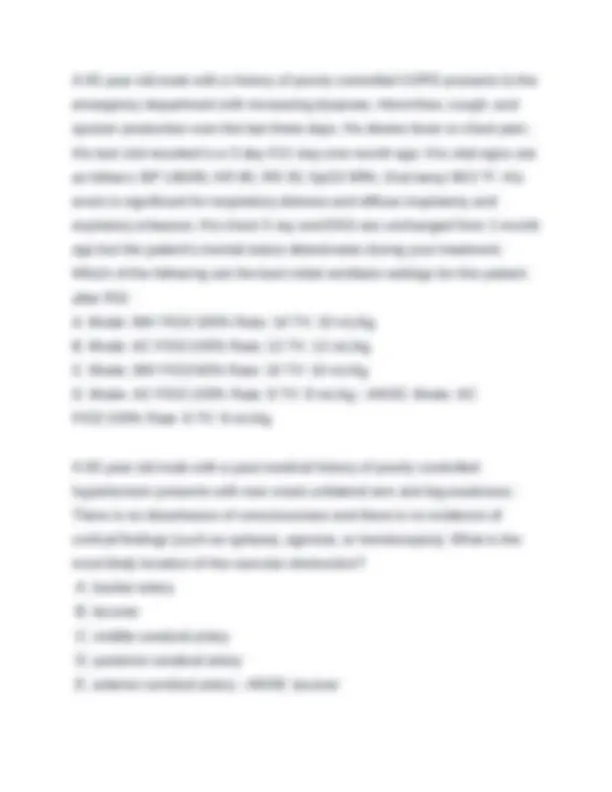
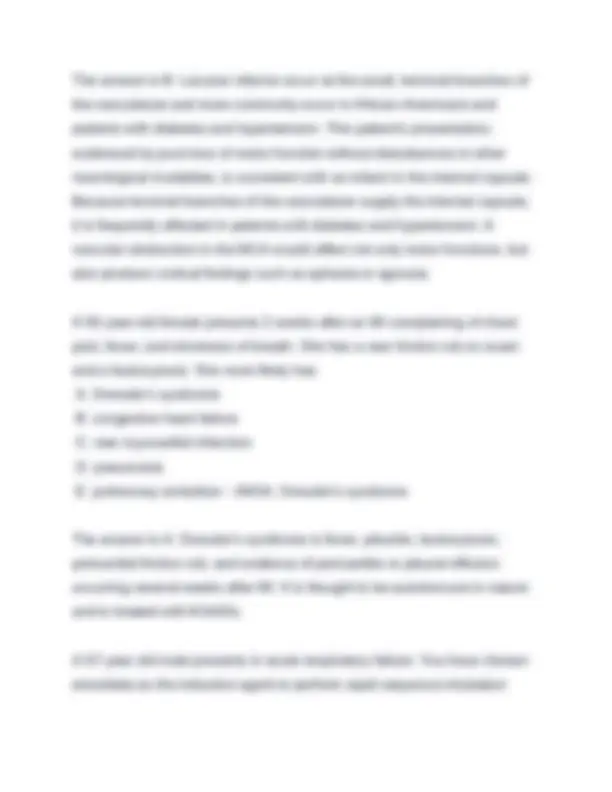
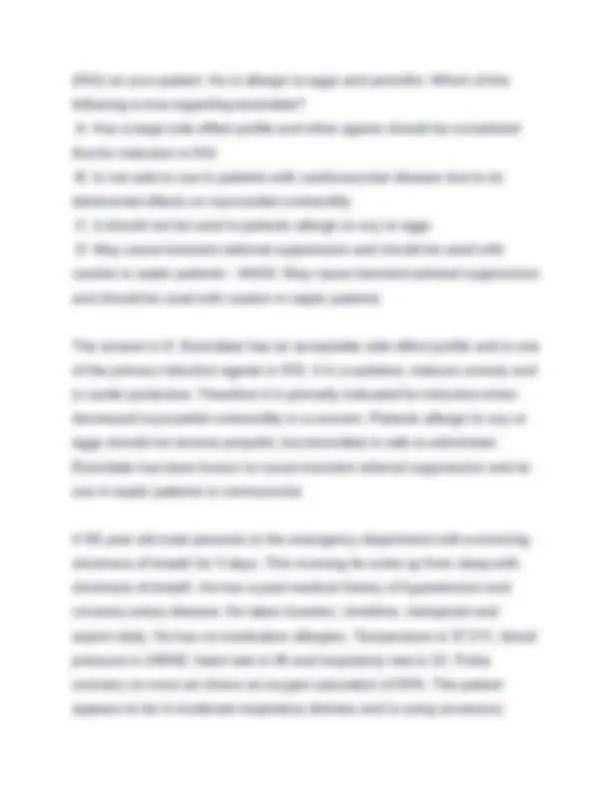
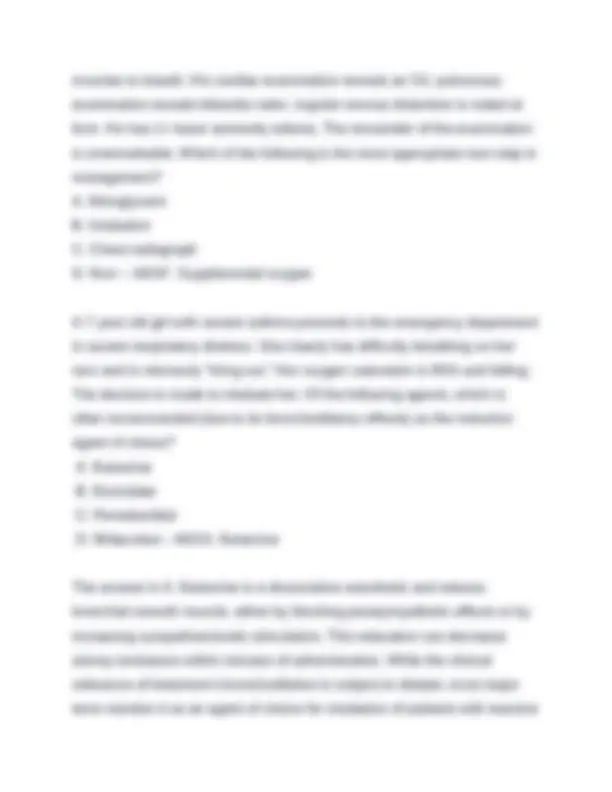
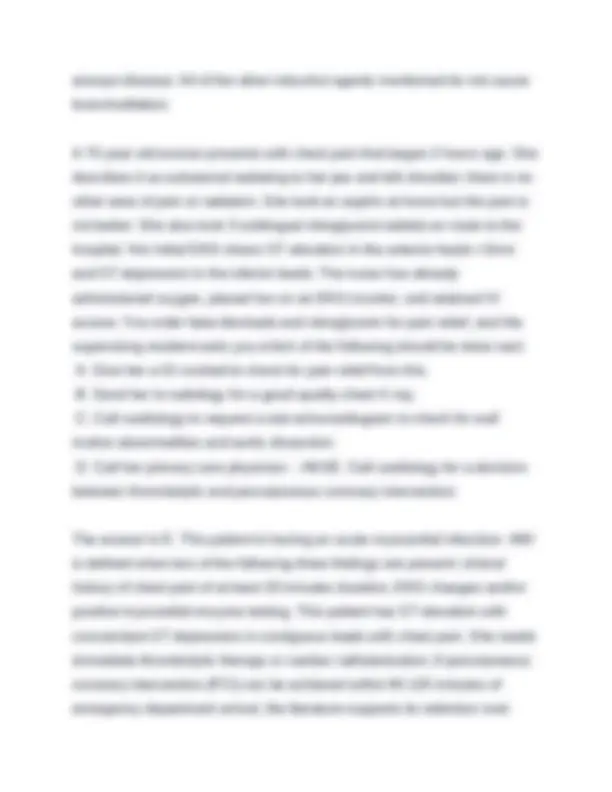
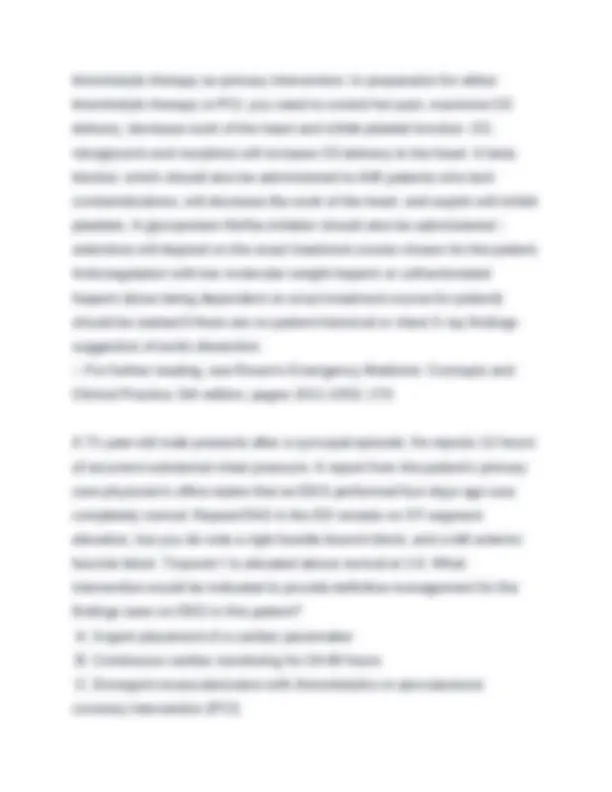
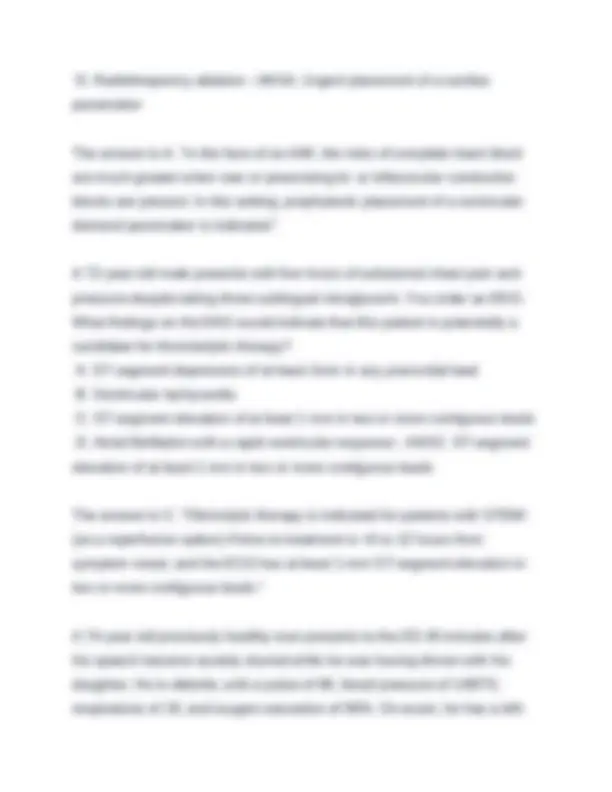
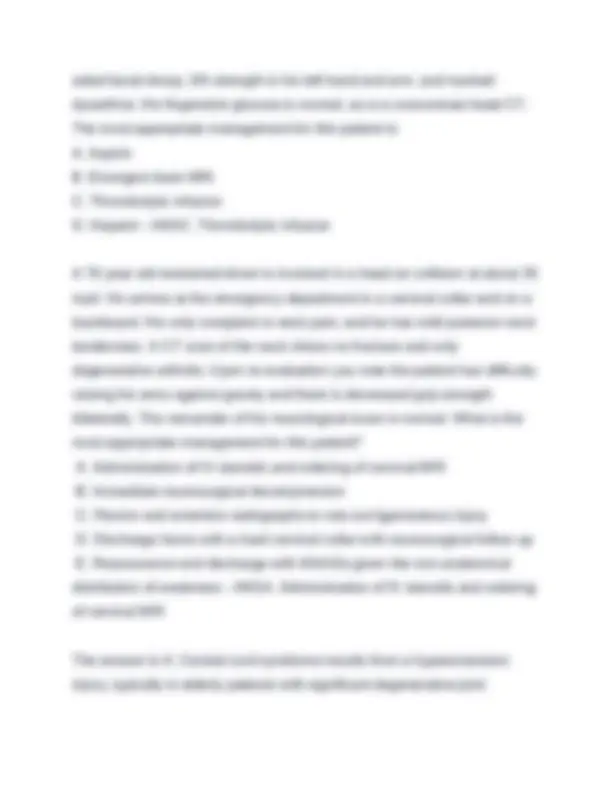
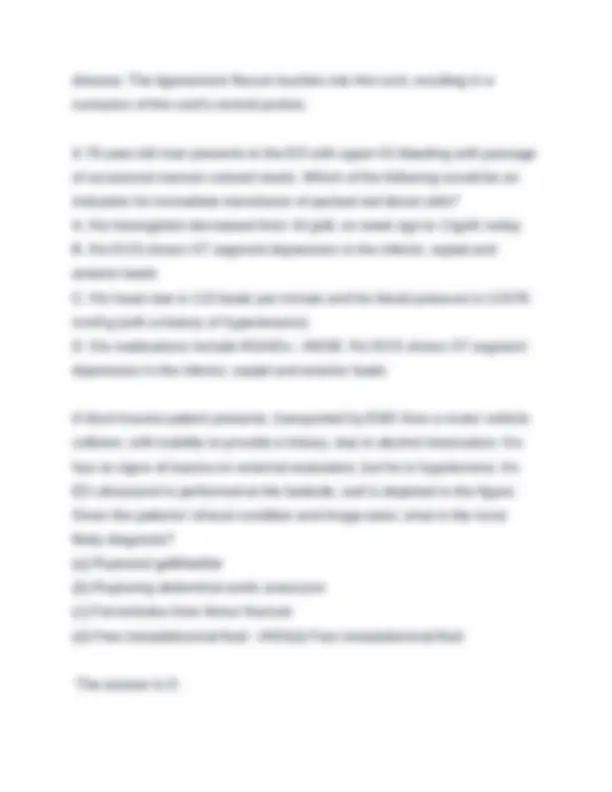
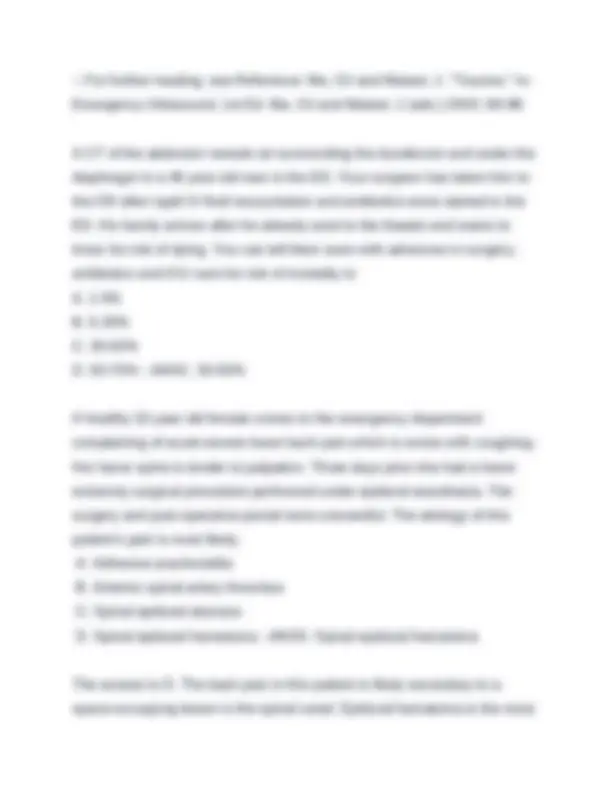
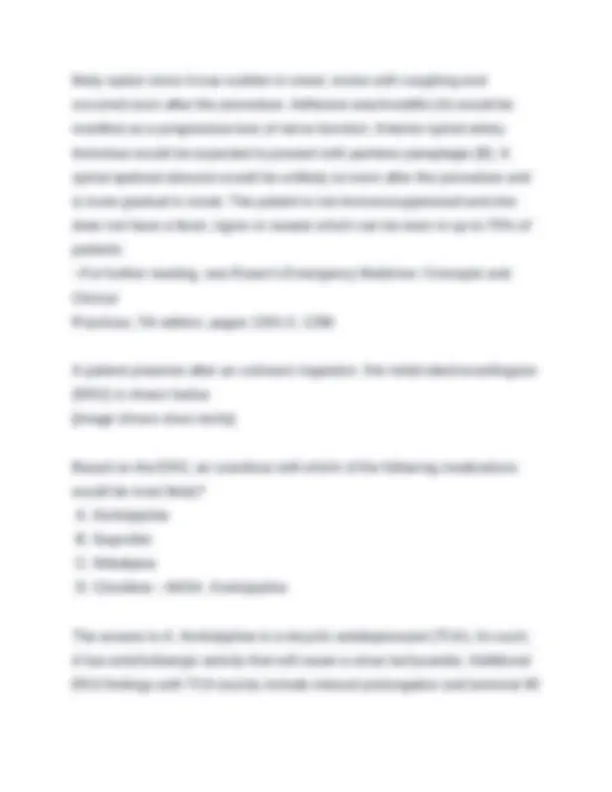
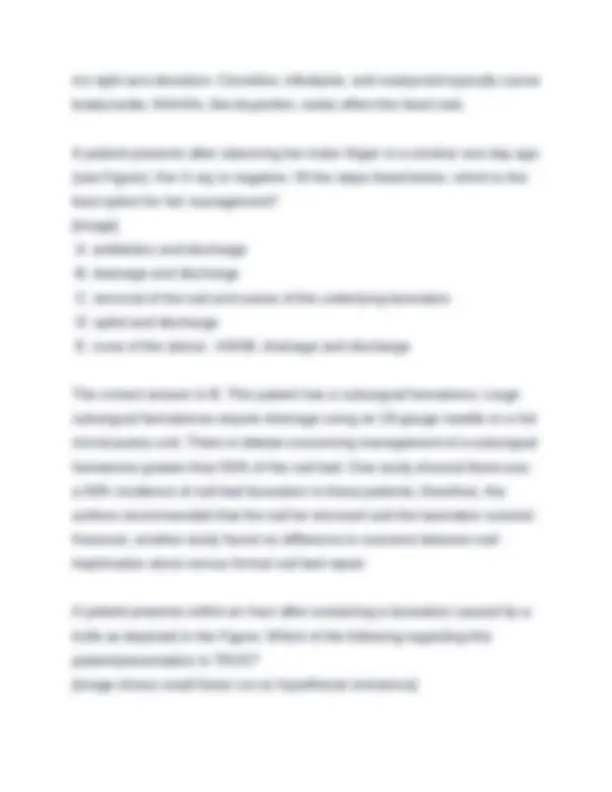
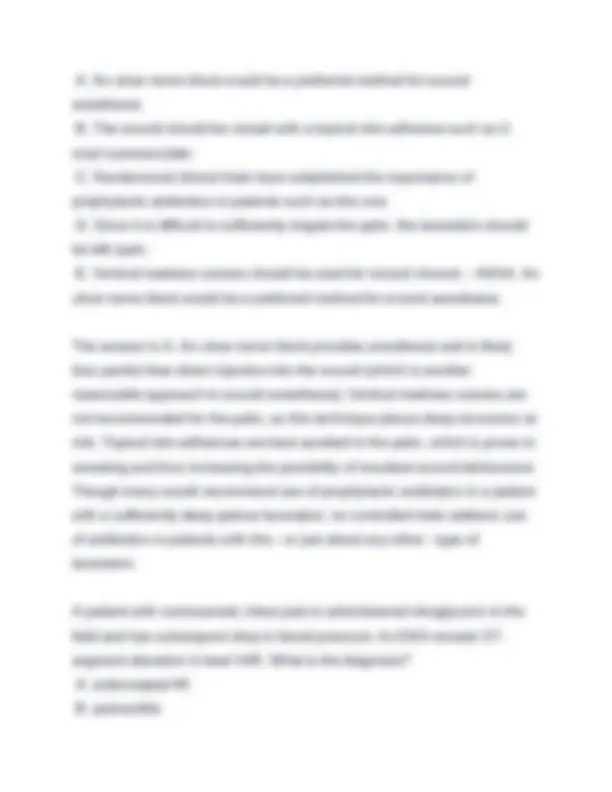
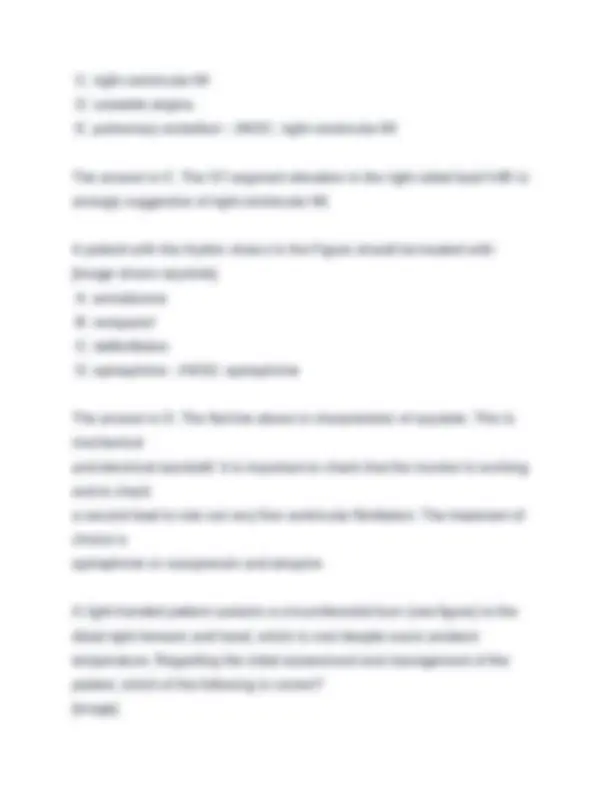
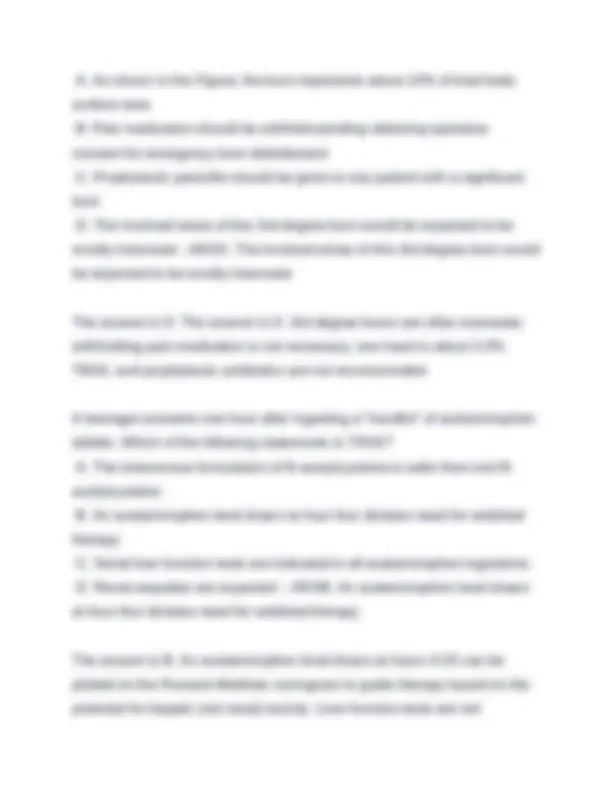
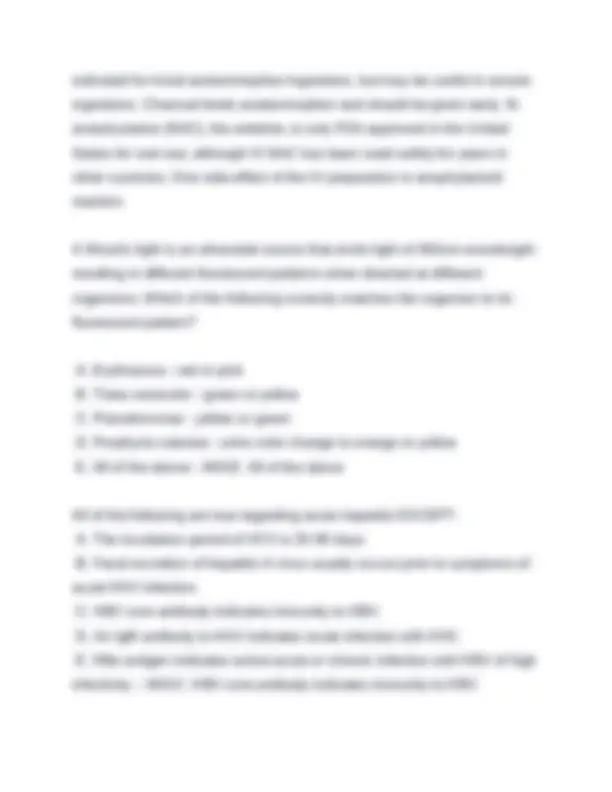
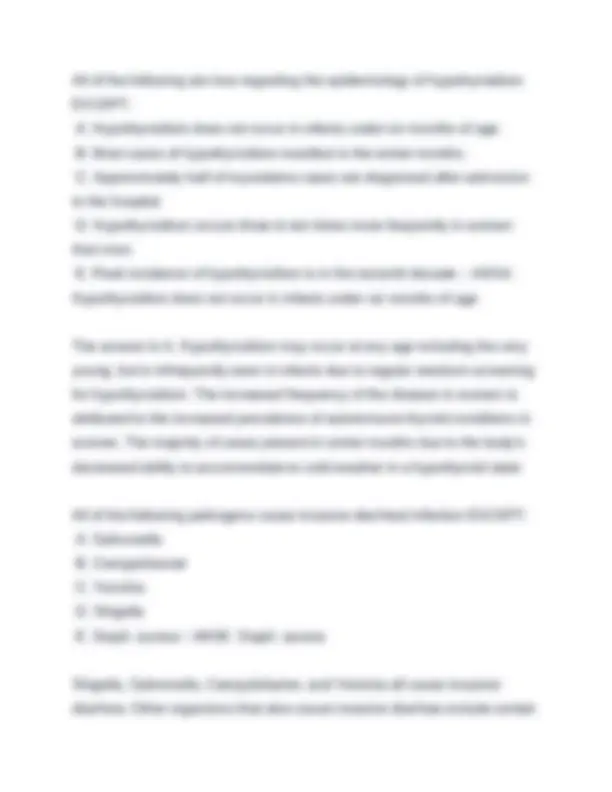
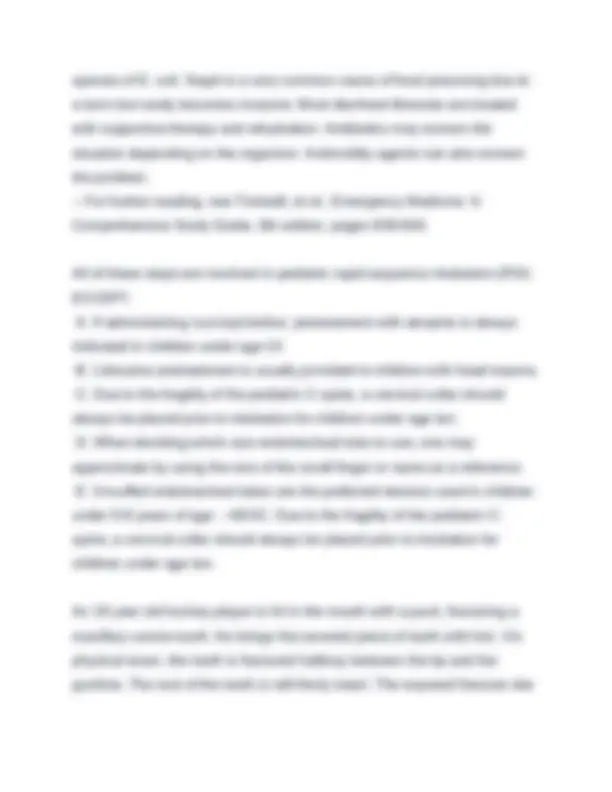
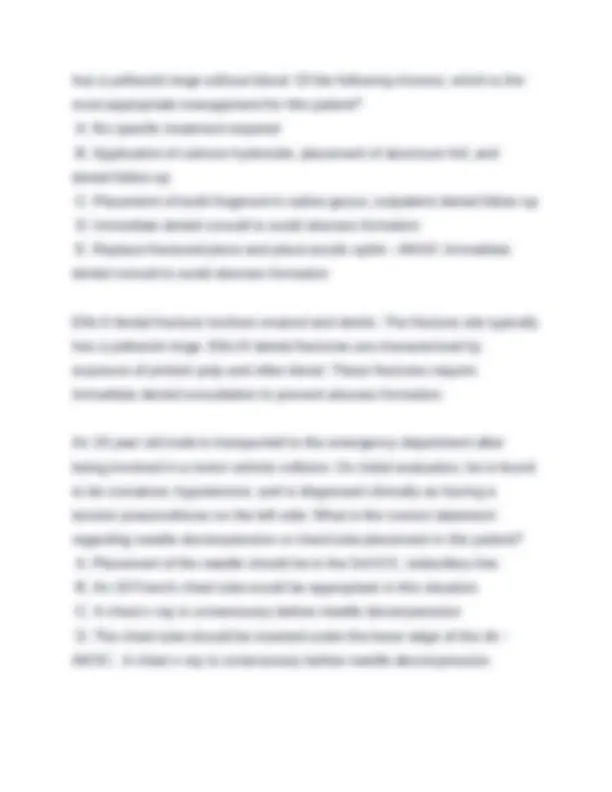
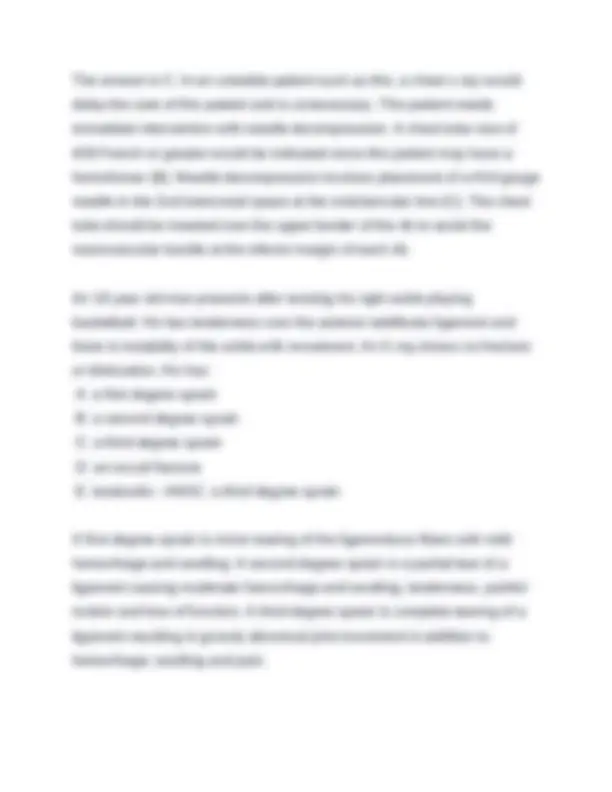
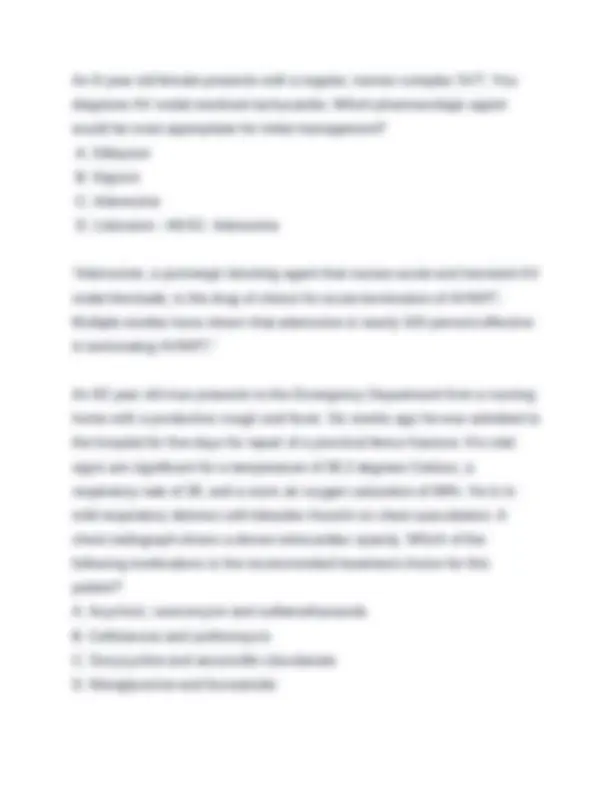
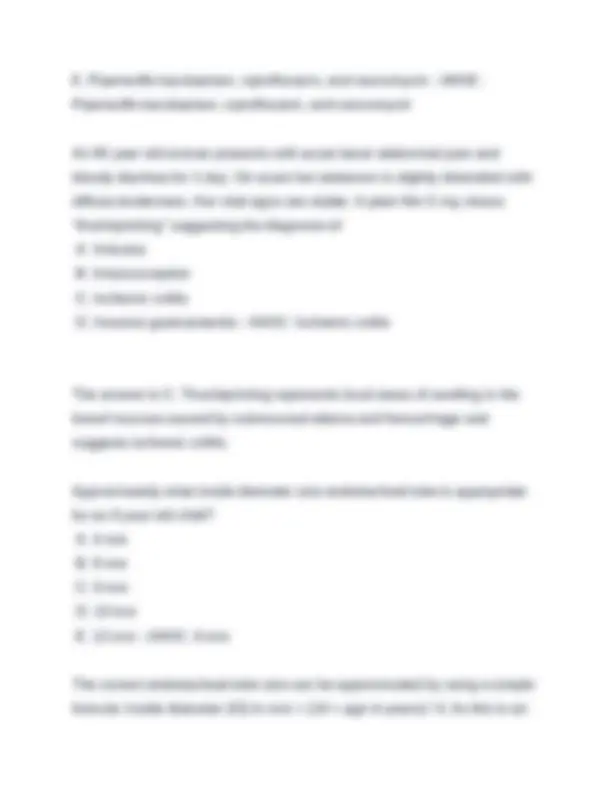
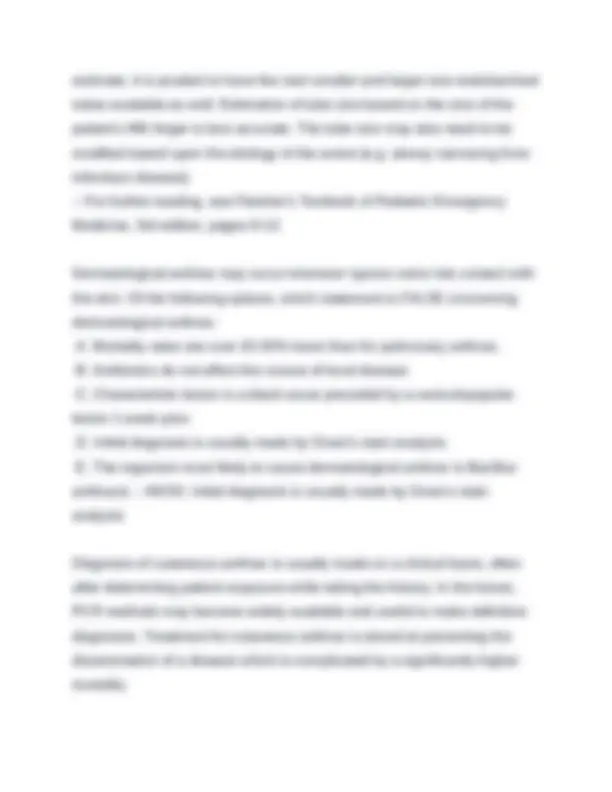
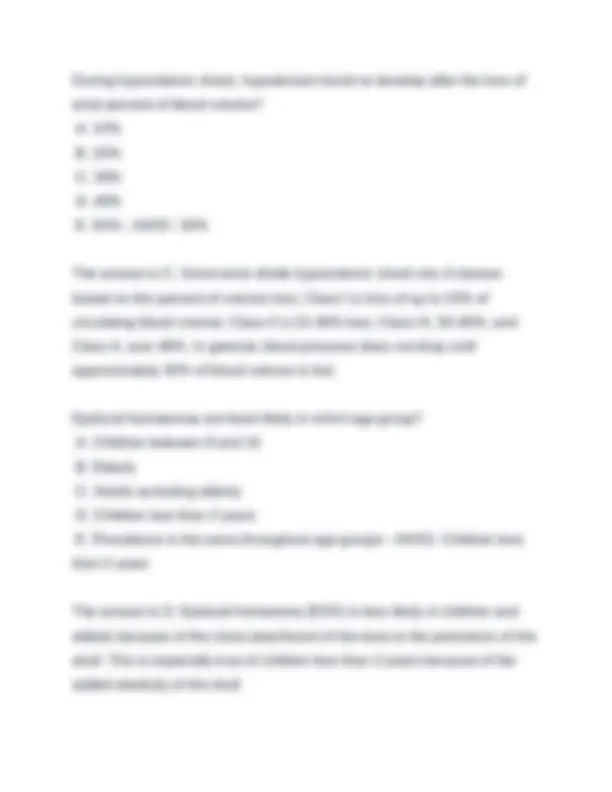
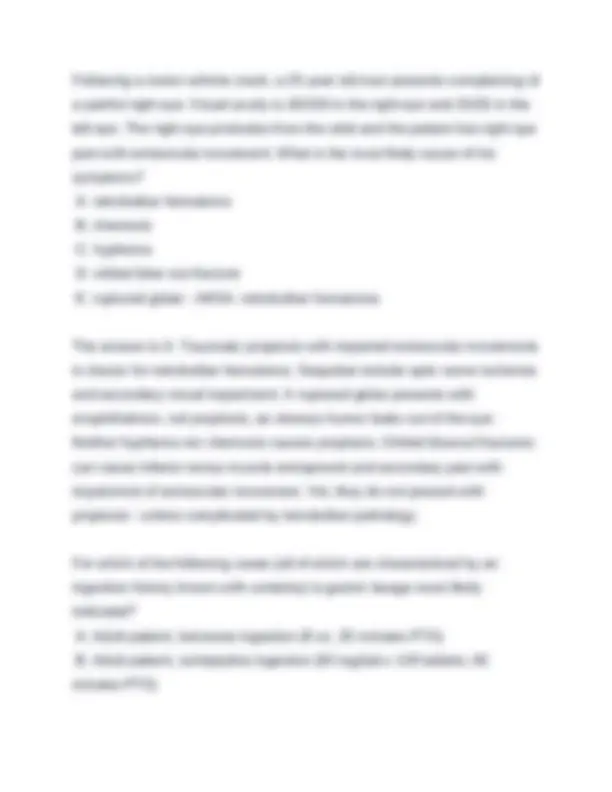
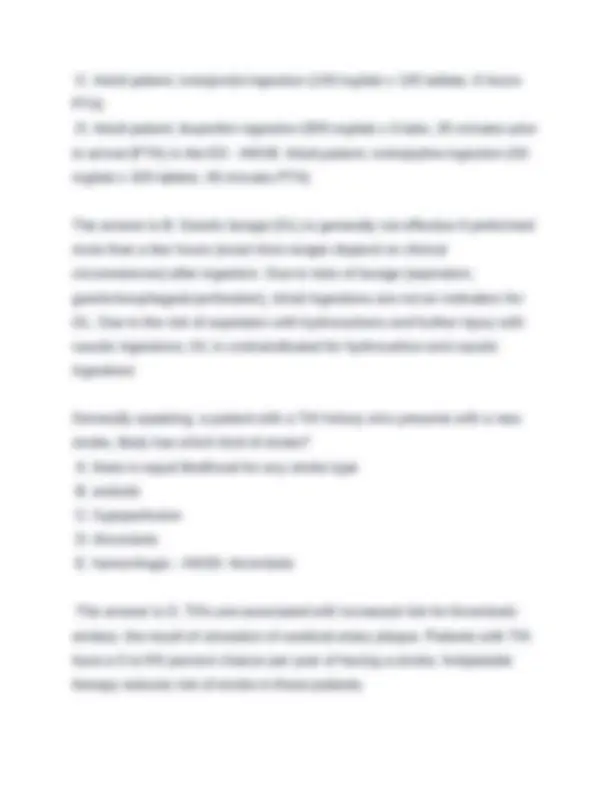
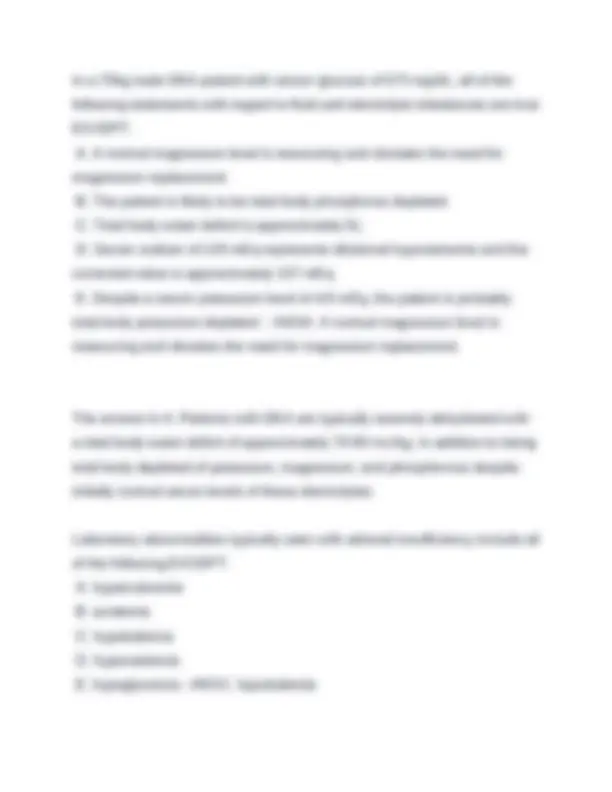
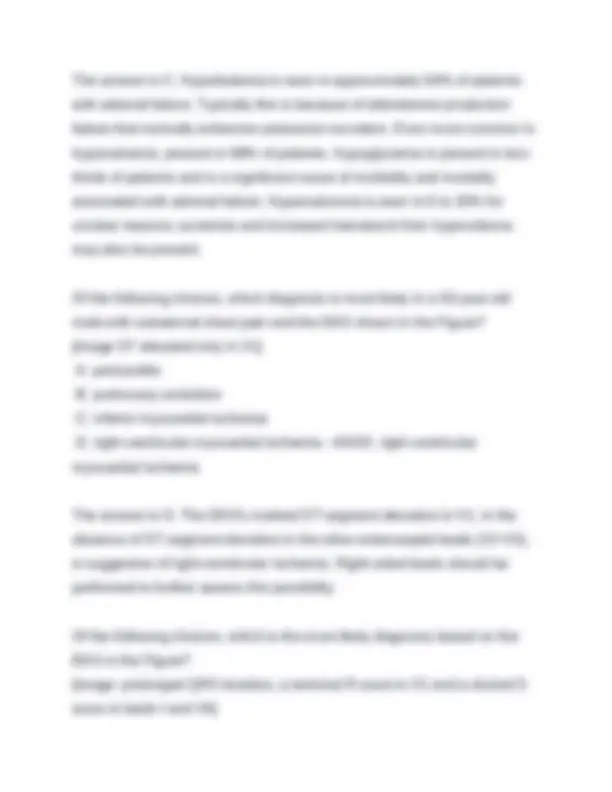
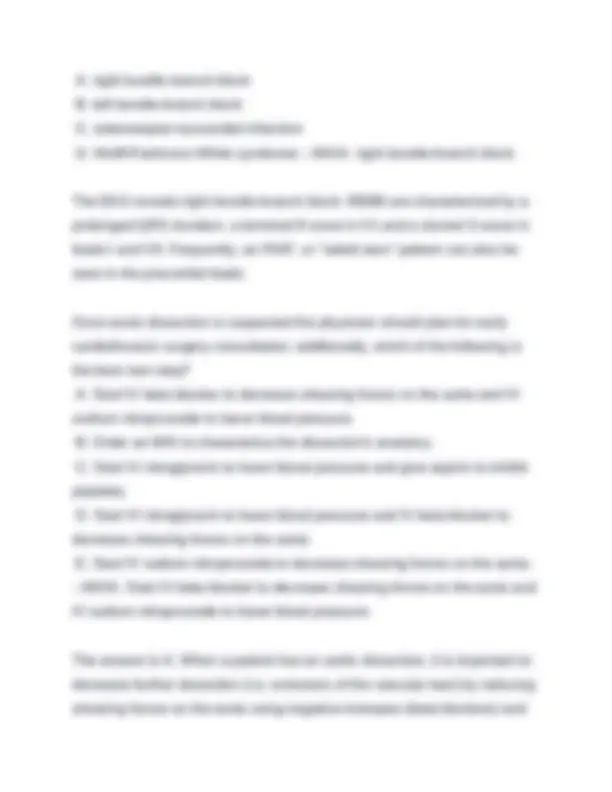
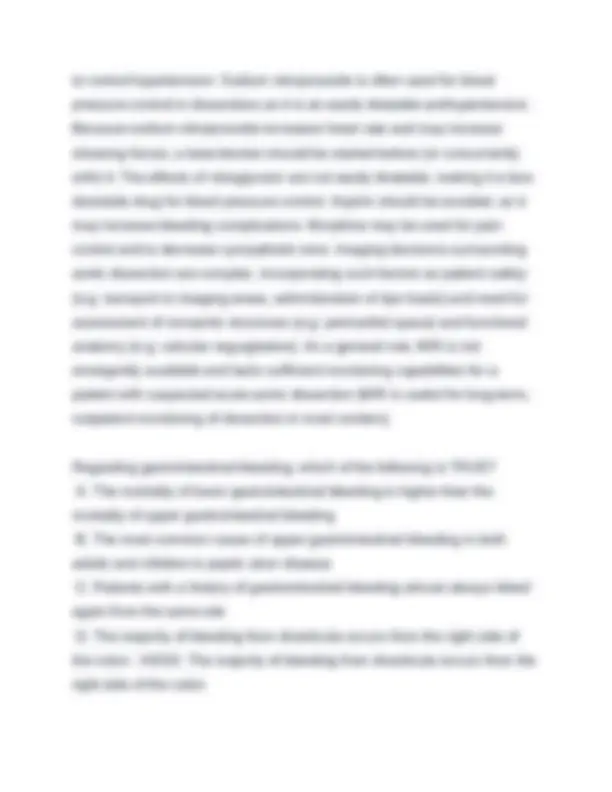
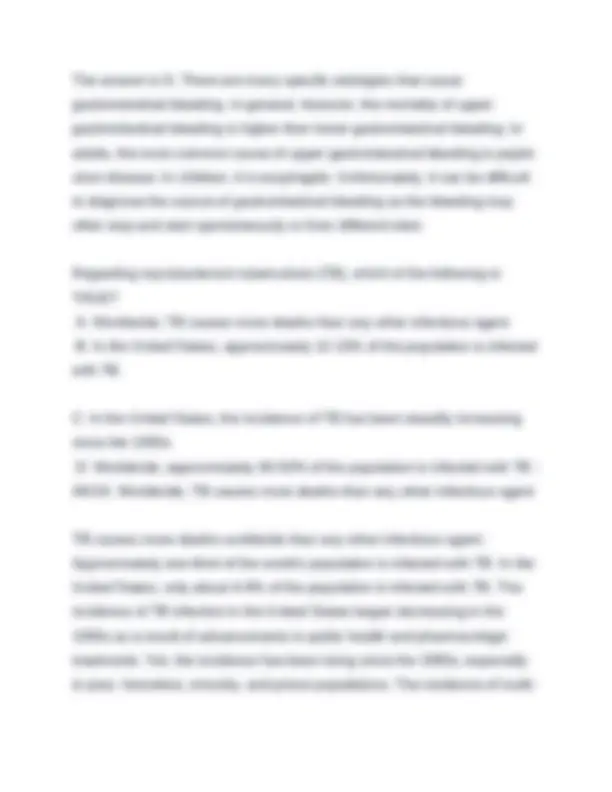
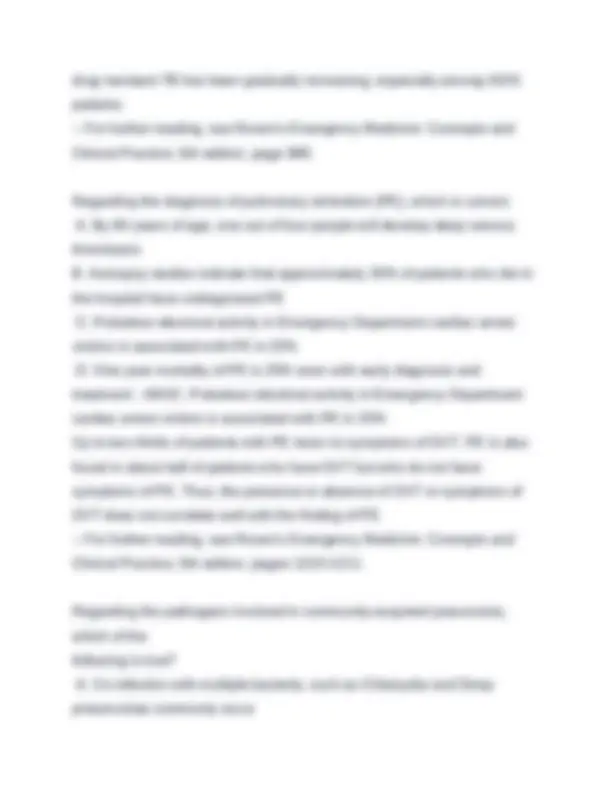
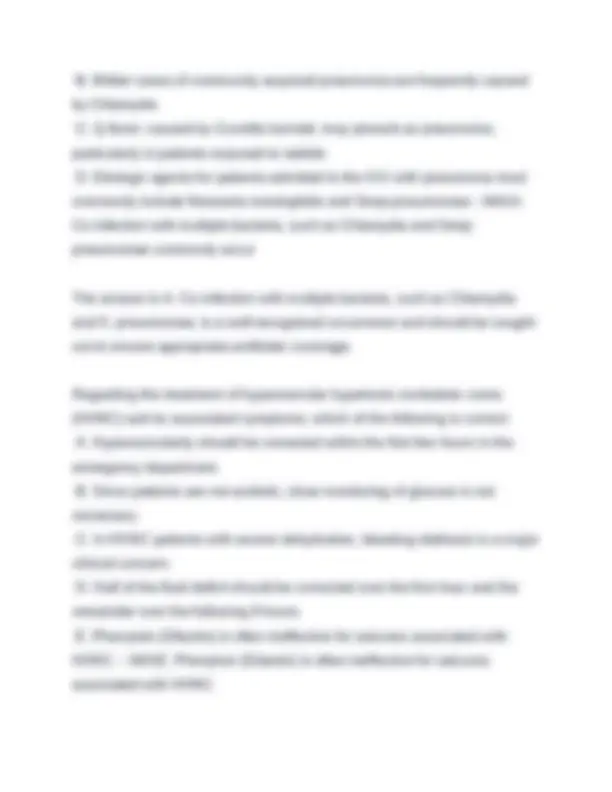
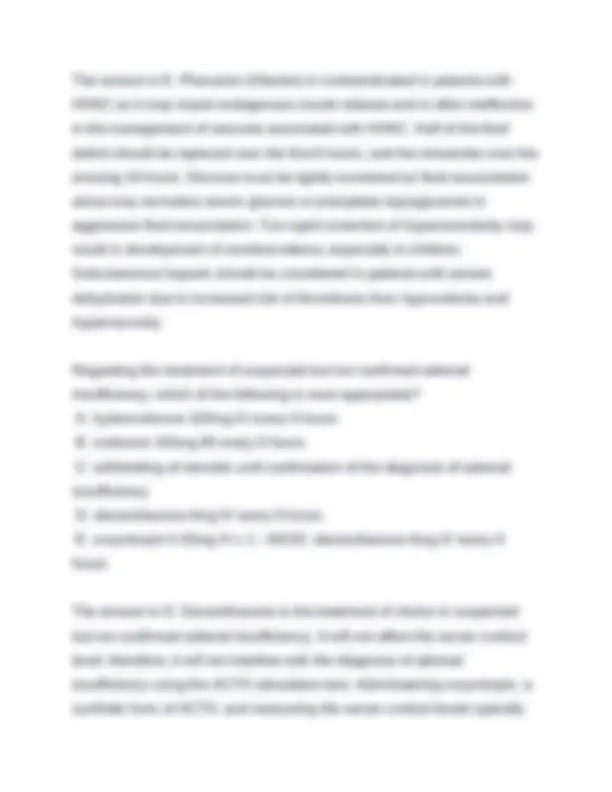
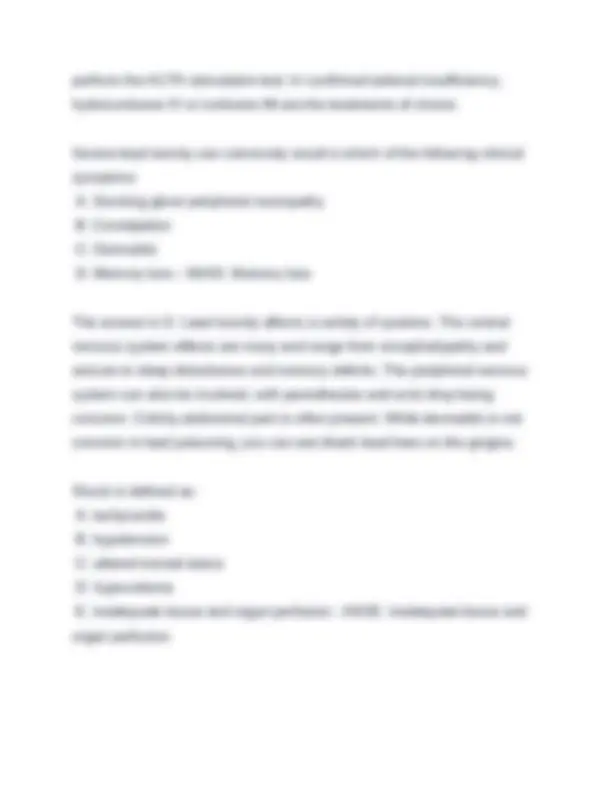
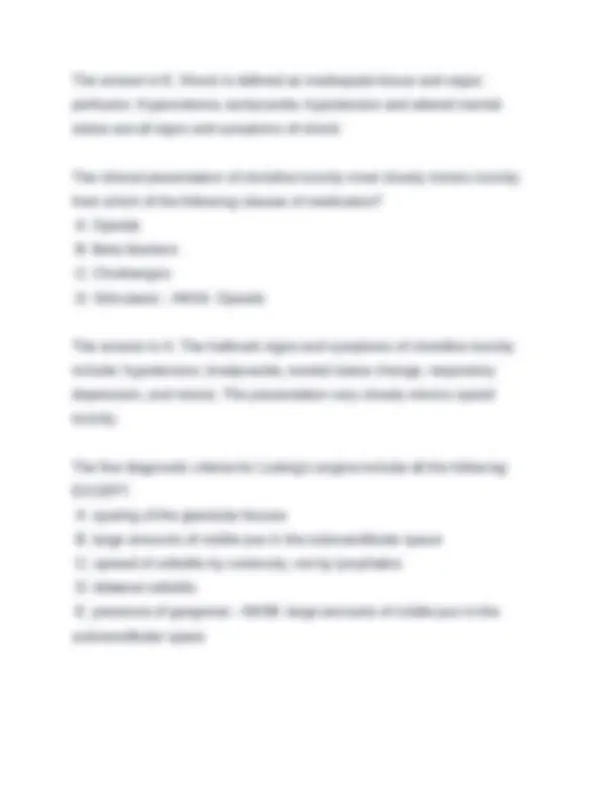
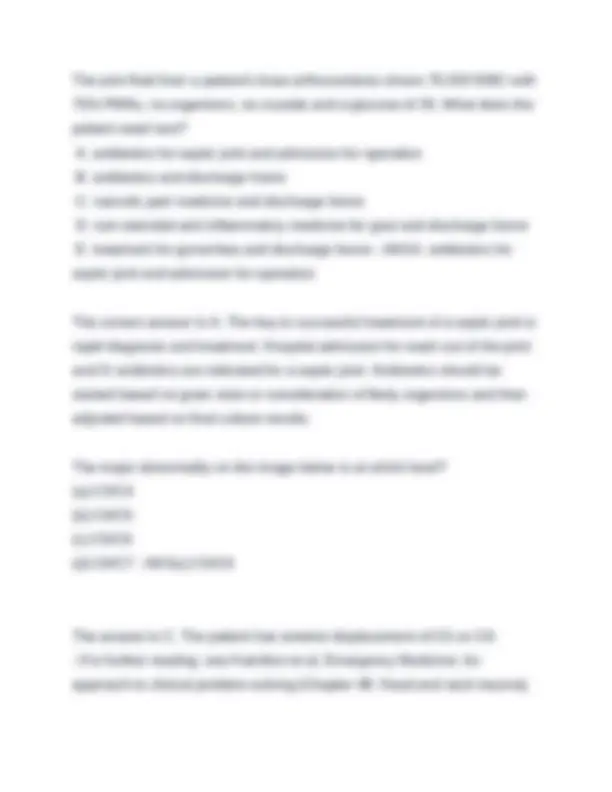
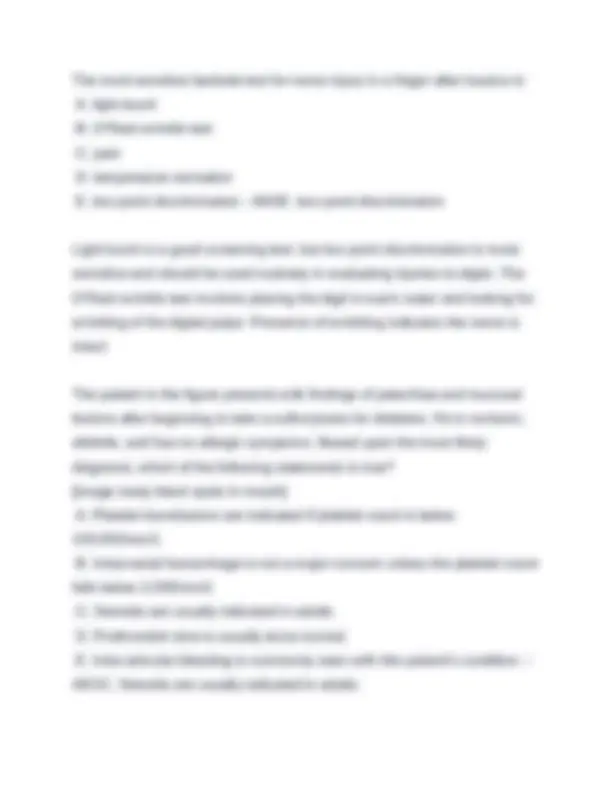
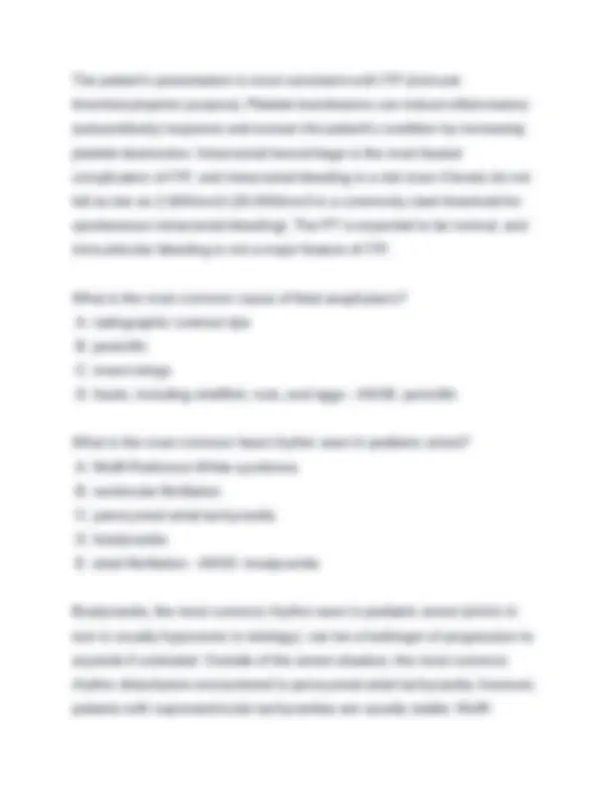
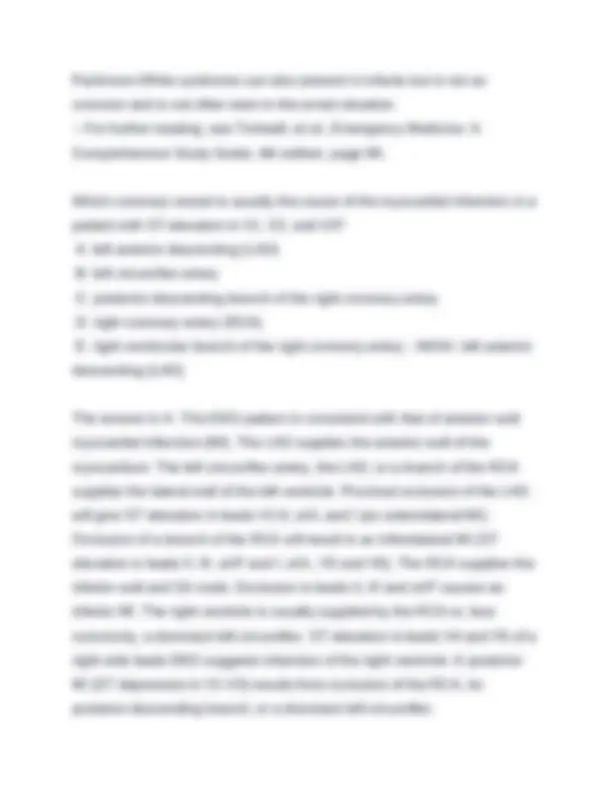
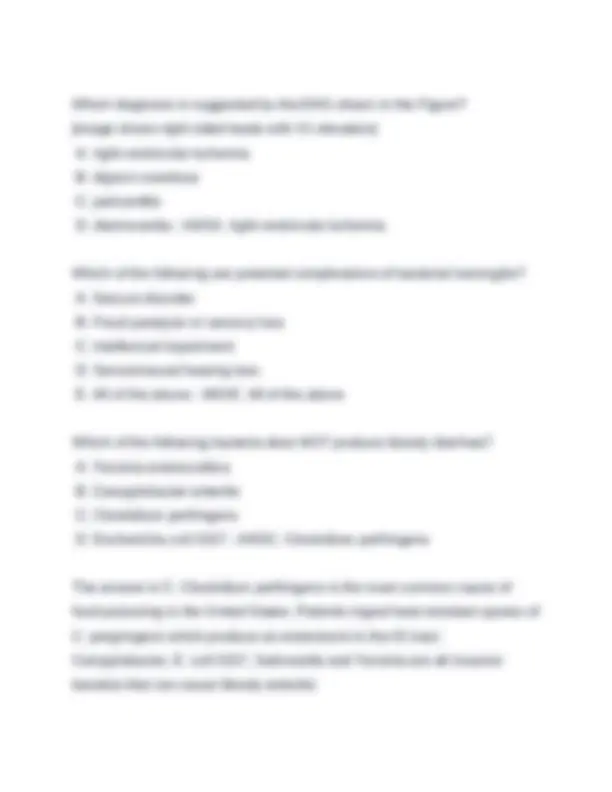
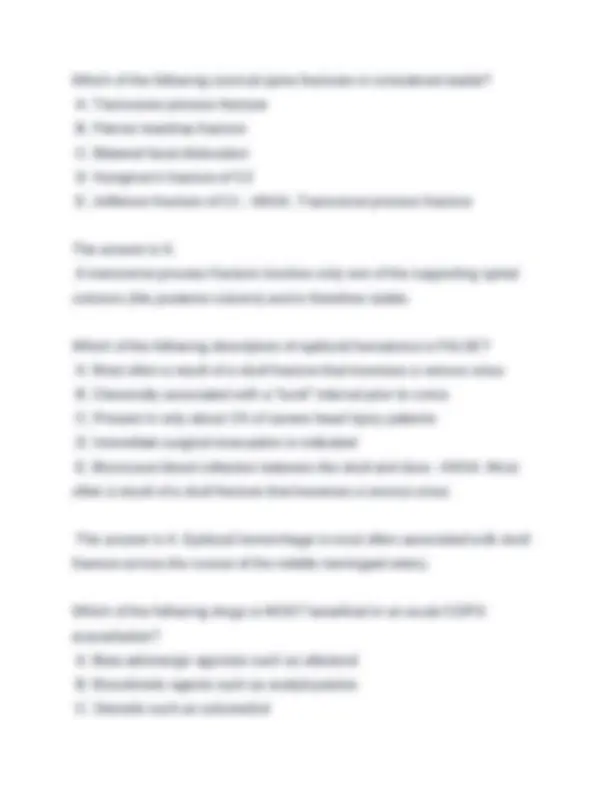
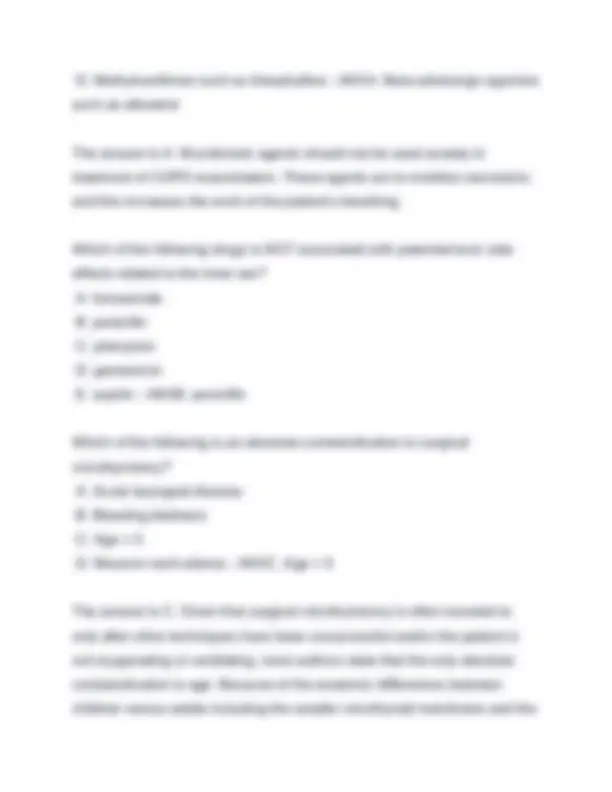
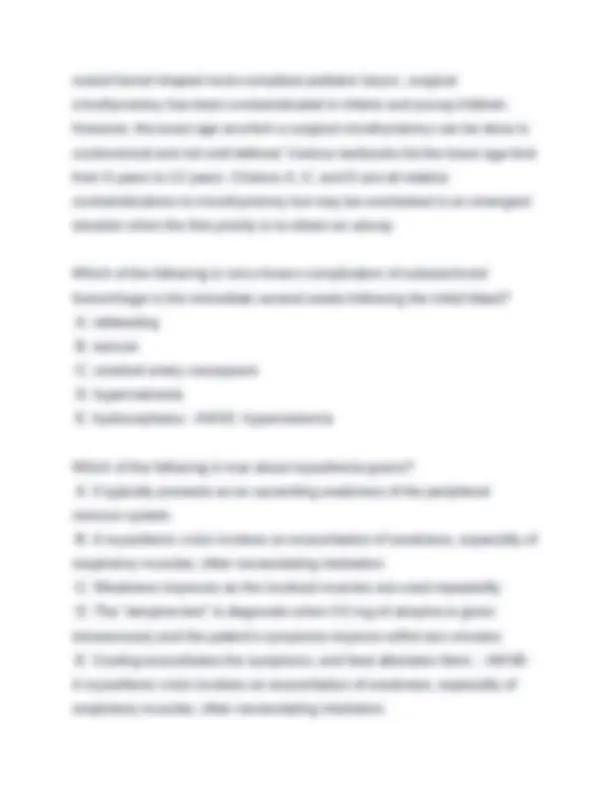
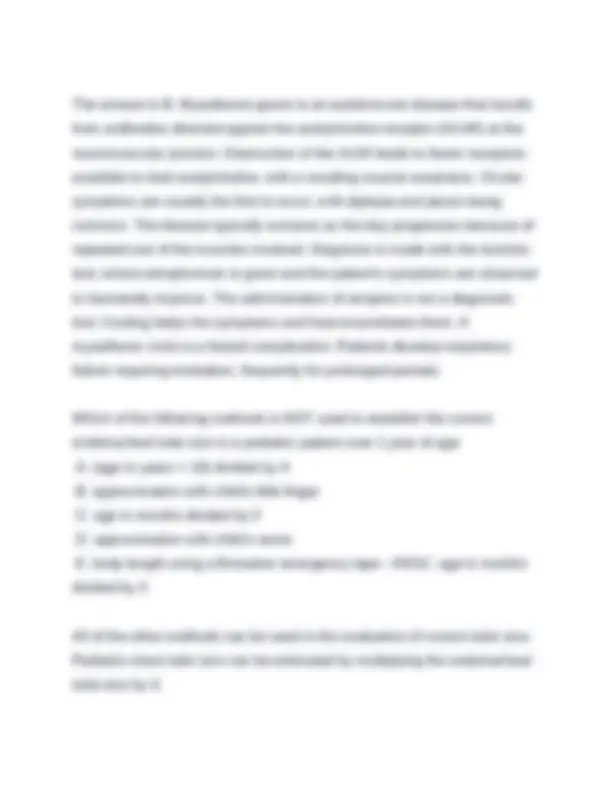
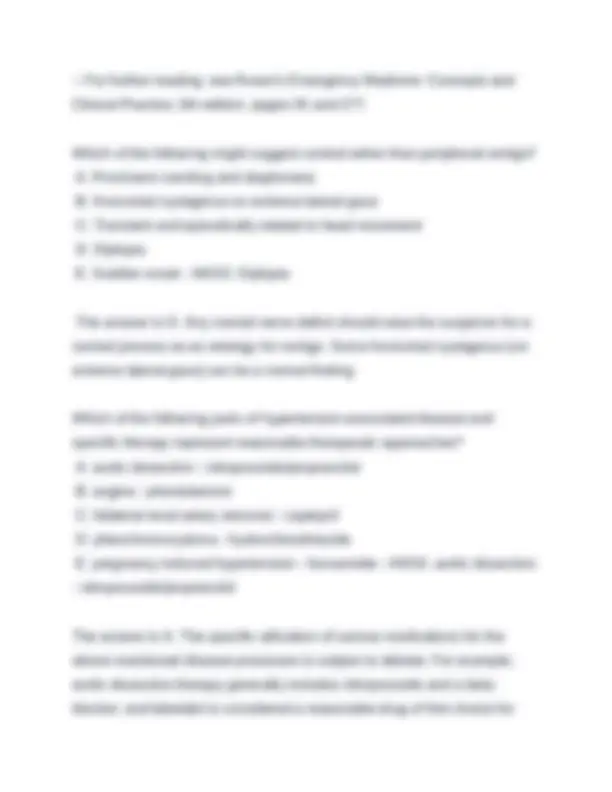
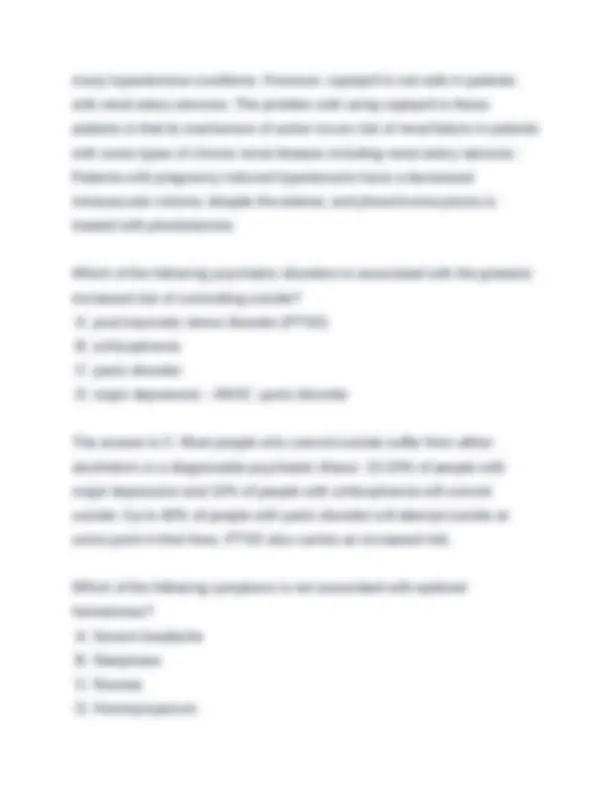
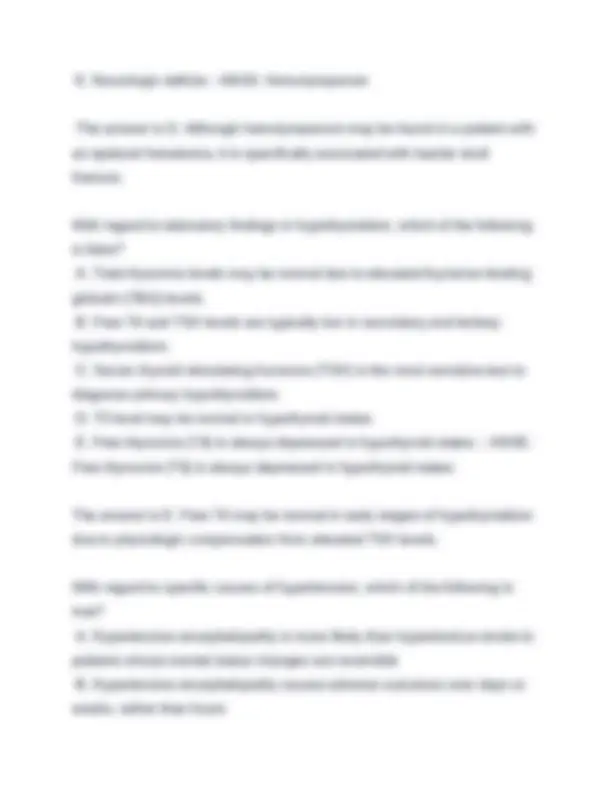
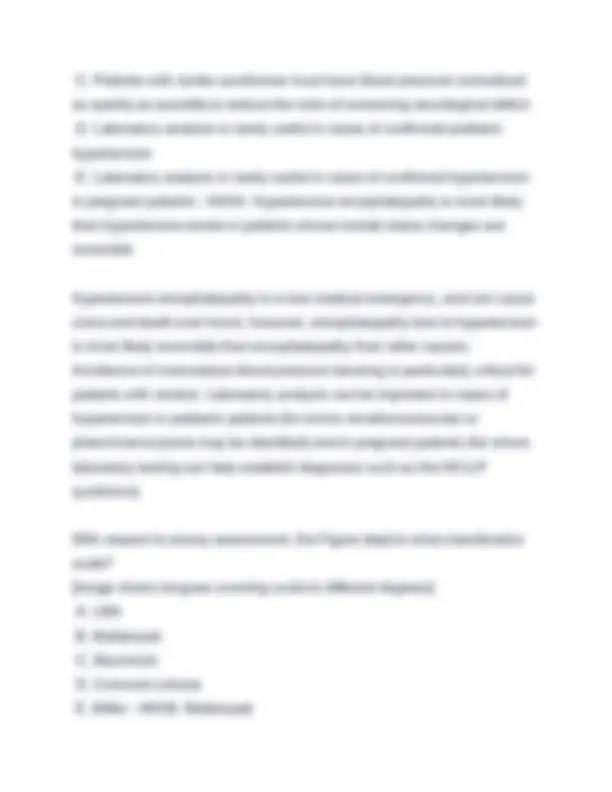
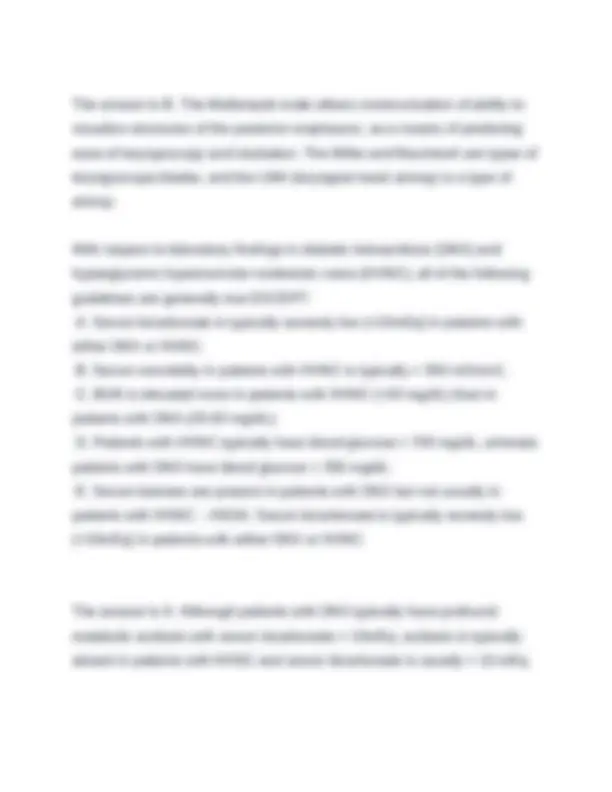
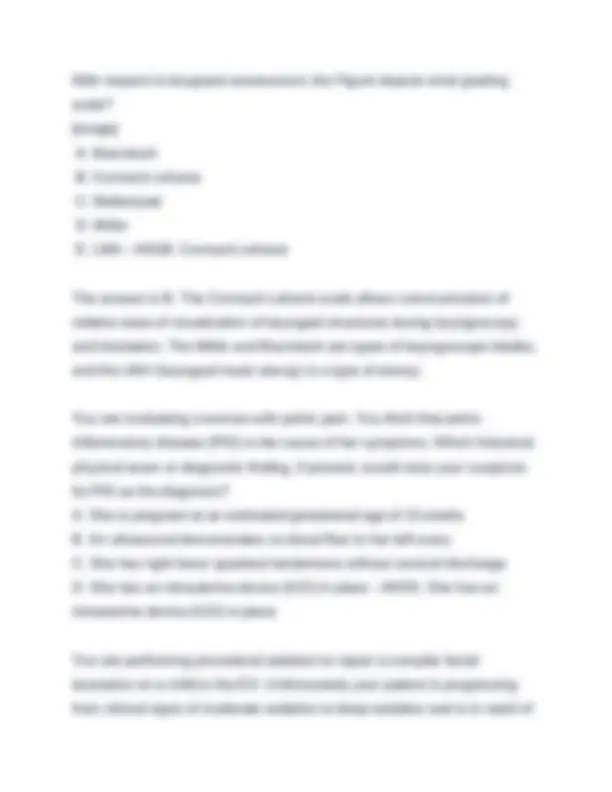
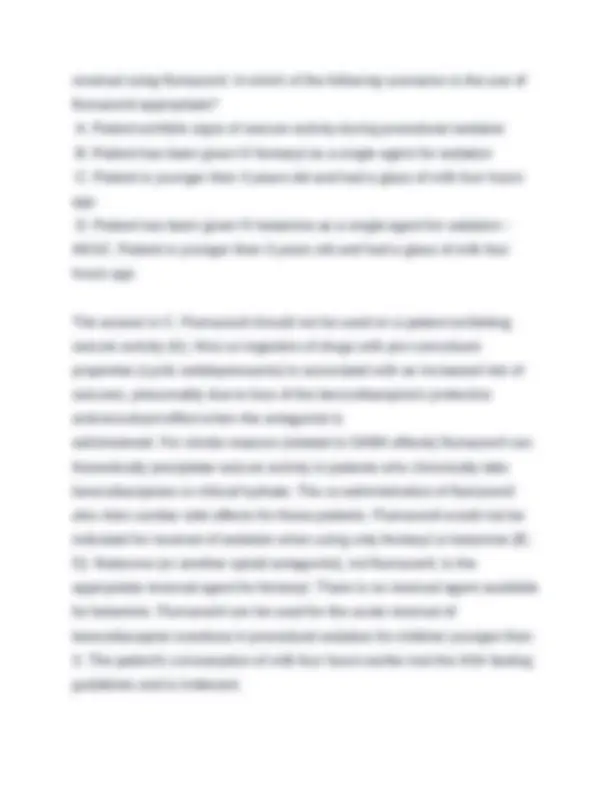
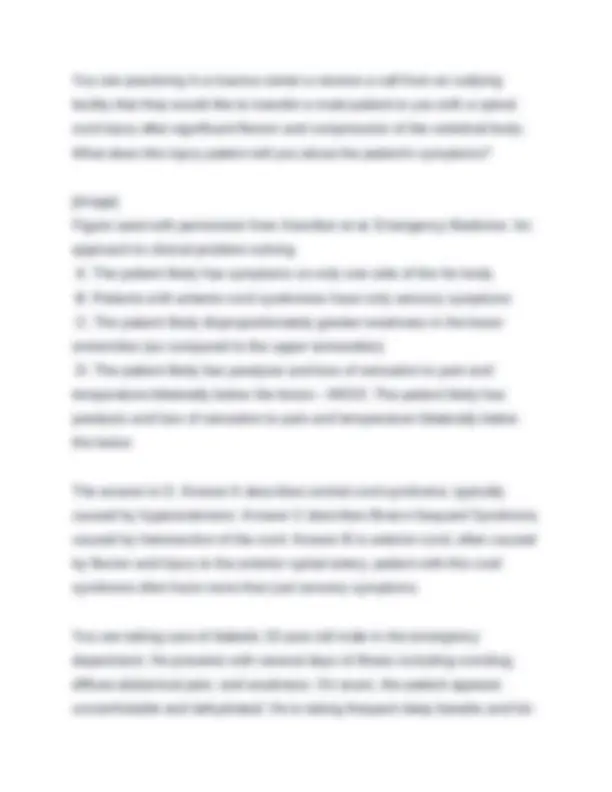
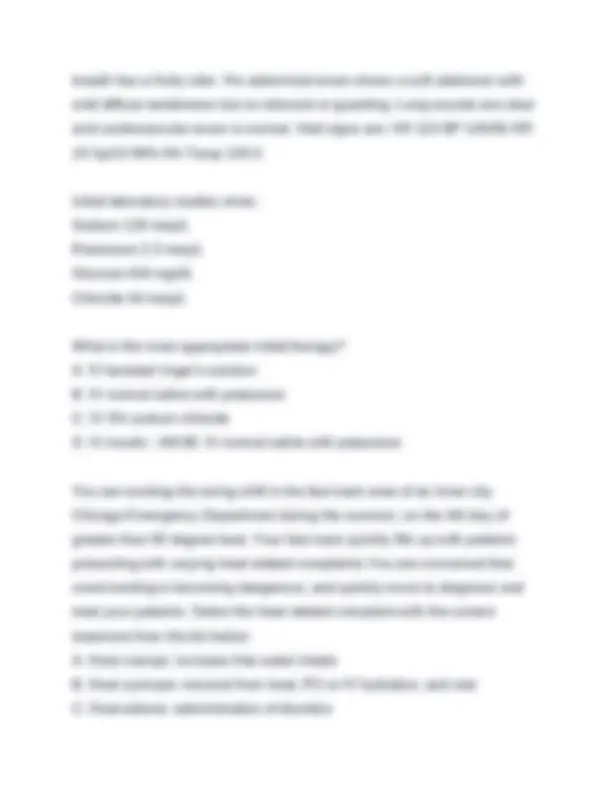
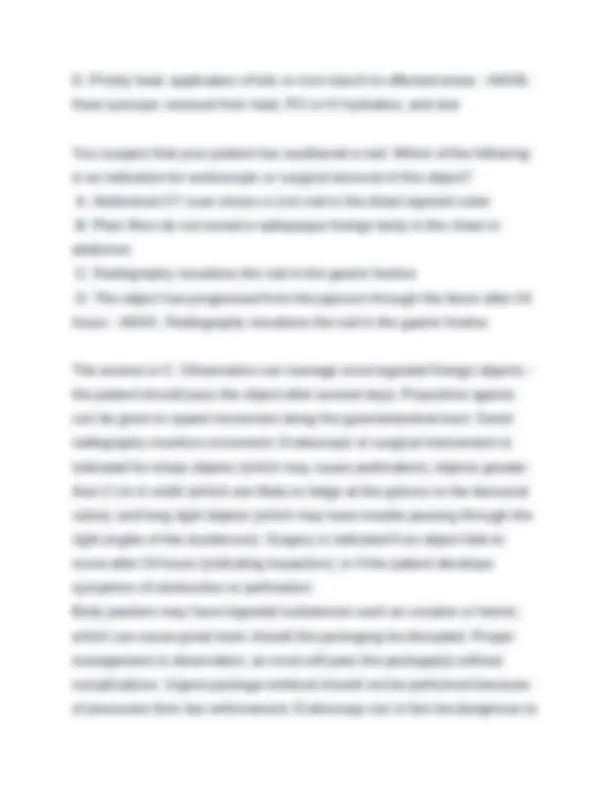



Study with the several resources on Docsity

Earn points by helping other students or get them with a premium plan


Prepare for your exams
Study with the several resources on Docsity

Earn points to download
Earn points by helping other students or get them with a premium plan
Community
Ask the community for help and clear up your study doubts
Discover the best universities in your country according to Docsity users
Free resources
Download our free guides on studying techniques, anxiety management strategies, and thesis advice from Docsity tutors
SAEM Practice Questions & Correct Verified Answers. Updated Versions 2025-2026. Graded A
Typology: Exams
1 / 96

This page cannot be seen from the preview
Don't miss anything!

























































































60 year old male presents to the emergency department with chest pain. His monitor strip, shown below, reveals: [image: unexpected, non-conducted atrial impulses. The R-R interval and P-R intervals are constant. ] A. first degree AV block B. complete heart block C. second degree AV block Mobitz Type 1 D. second degree AV block Mobitz Type 2 - ANSD. second degree AV block Mobitz Type 2 -- For further reading, see Tintinalli, et al., Emergency Medicine: A Comprehensive Study Guide, 5th edition, page 184. A 14 year old presents just after smoking crack cocaine and complains of chest pain. He describes it as sharp and stabbing in the middle of his chest. His EKG is normal. The intern reads the CXR as "negative" but your supervising resident asks you to have another look (see Figure), after which you make the diagnosis of: [image: big round heart, black in mediastinum, widened] photo courtesy of eMedicine.com A. Pneumonia
B. Aortic dissection C. Congestive heart failure D. Pneumomediastinum - ANSD. Pneumomediastinum The answer is D. Look closely along the right heart border and mediastinum. There is a thin strip of air. Pneumomediastinum and pneumopericardium result from Valsalva maneuvers, barotrauma, asthma, and cocaine inhalation from positive pressure devices. On physical exam there may be a Hamman's sign or mediastinal crunch heard over the precordium. Westermark's sign is dilation of pulmonary vessels proximal to a pulmonary embolism resulting in a cut-off appearance of the vessel on CXR. A 14 year-old child presents to the emergency department. His blood pressure is 210/140. He complains of a headache, nausea, and recent blurred vision. Of the following choices, the best goal for lowering his mean arterial blood pressure is to have it drop by: A. Until symptoms resolve B. 5% in the first 5-6 hours C. 25% in the first hour D. 50% in the first hour E. To normal for his age in the first hour - ANSC. 25% in the first hour The answer is C. A systolic BP of 210 or more, or a diastolic BP of 140 or greater, with end-organs symptoms, the presumptive diagnosis is hypertensive emergency. In hypertensive emergencies, the goal is to
D. ceftriaxone IV E. azithromycin IV - ANSD. ceftriaxone IV The answer is D. In patients with meningitis, early antibiotics administration is of the utmost importance. Antibiotic administration should not be delayed to await diagnostic work up. Ceftriaxone, administered in some regions with vancomycin depending on the resistance profile of likely etiologic agents, is generally considered an antibiotic of choice in meningitis. Azithromycin and levofloxacin do not have good CNS penetration and therefore are not indicated for meningitis. A 19-year-old G1P0 female, at 38 weeks EGA, presents to the emergency department complaining of headache, blurry vision and leg swelling. The physical examination reveals BP of 150/100, facial and hand edema, and hyperreflexia. Fetal heart monitoring demonstrates a reassuring pattern with no uterine contractions. Urine dipstick reveals 2+ proteinuria. Of the following, which factor is the most critical in formulating an ultimate management plan for this patient? A. Extent of maternal edema B. Fetal age C. Presence of variable decelerations on nonstress testing D. Symptom duration - ANSB. Fetal Age The cure for pre-eclampsia is delivery of the baby, and the fetal age and maturity are the most important factors to consider in determining the planning for delivery. For pregnant women at or near term, induction of labor is usually indicated.
A 2 year old male is brought to the ED in status epilepticus. He has not responded to adequate doses of benzodiazepines. Which of the following possible causes of a seizure must be evaluated for in the emergency department? A. Hypoxia B. Hypoglycemia C. Toxic ingestion D. Head trauma E. All of the above possible causes must be evaluated for - ANSE. All of the above possible causes must be evaluated for The answer is E. Seizures have a number of secondary causes, which must be identified and corrected before the seizure will end. Hypoxemia and hypoglycemia are easily detected by pulse oximetry and bedside measurement of glucose, respectively. Toddlers may ingest many toxins accidentally, such as INH, tricyclic antidepressants, and camphor. Trauma must be considered, too, including child abuse. Sickle cell disease, SLE, and leukemia are some of the medical causes of seizures and status epilepticus. A 20 year old college female recently returned from spring break after hiking in the Virginia woods approximately two weeks prior to her presentation to the E.D. One day prior to presentation, she developed fever, chills, and anorexia. In the emergency department, she complains of headache, photophobia, and myalgias. On exam, one notices a
The answer is C. Moderate hypothermia is associated with temperatures of 28-32 C. Shivering ceases at about 32 degrees Celsius. Moderate hypothermia is associated with altered mental status, absence of shivering, bradycardia, and bradypnea A 20 year-old man presents to the Emergency Department with right-sided chest pain and dyspnea. His symptoms started while walking his dog five hours ago. He describes the pain as sharp, pleuritic, and diffuse throughout his right chest. He has a history of asthma for which he takes albuterol as needed. He took four puffs of his inhaler today without relief. He has no surgical history, and reports occasional cigarette and alcohol use. He denies trauma. On exam, he appears uncomfortable. He has a heart rate of 105 beats/minute, a blood pressure of 145/85, a respiratory rate of 22 breaths/minute, a temperature of 98.9 degrees Fahrenheit and a pulse oximeter reading of 93% on room air. He has decreased breath sounds heard over his right chest. A triage chest x-ray is shown. What is the most appropriate next step in managing this patient? A. Insert a tube thoracostomy B. Administer empiric antibiotics C. Administer predn - ANSA. Insert a tube thoracostomy A 21-year-old woman presents to the emergency department with fevers, headache, neck stiffness, and mild confusion over the past several days. Her temperature is 38.0 C (100.4 F), pulse 106, and blood pressure 116/74. On physical exam she looks ill, and her neck is stiff. Her neurologic exam is normal. A lumbar puncture reveals 105 WBC and 1240 RBC in
tube #1 and 126 WBC and 1360 RBC in tube #4; all white cells are lymphocytes. The CSF protein is 68 and the glucose is 78. This patient most likely has which of the following? A. HSV encephalitis B. Pneumococcal meningitis C. Subarachnoid hemorrhage D. Subdural hematoma - ANSA. HSV encephalitis A 22 year old G2P1 female with history of pelvic inflammatory disease presents to the Emergency Department with worsening LLQ pain over the past six hours. Pelvic exam reveals scant blood on speculum exam, closed os, and left adnexal tenderness. The beta hCG is 571. Following ACEP's clinical policy, you obtain a pelvic ultrasound to assess the probability of ectopic pregnancy. Which of the following is the earliest diagnostic evidence (100% predictive) for the presence of intrauterine pregnancy? A. Double decidual sac sign B. Yolk Sac C. Fetal heart motion D. Gestational sac - ANSB. Yolk Sac A 22 year old presents with chest pain and the following EKG: [image: Septal ST elevations] He reports no past medical history and no family history of medical problems. Which substance should you specifically question him about using?
The answer is B. Antidepressant overdose is the most common cause of suicide by ingestion. Cyclic antidepressants are associated with a higher potential for lethality than other antidepressant medications. Often during the early stages of recovery from major depression, patients may have a "mobilization of energy" which allows them to act on their suicidal thoughts, for which they previously lacked the energy. A 23 year old male college student presents to the emergency department with fever and a headache. He has been ill for 3 days, with fever starting yesterday. Today he noted a rash on his legs. Exam is remarkable for photophobia, neck stiffness and pain with movement, and a petechial rash on his legs and hands. As an astute medical student, you suggest to your resident that an LP needs to be performed to rule out meningitis. Your resident challenges you further and asks what studies you're going to order on the CSF. What do you tell him? A. albumin, LDH, cell count, glucose B. cell count, glucose, crystal analysis, gram stain C. gram stain, LDH, cell count, albumin D. cell count, glucose, protein, gram stain - ANSD. cell count, glucose, protein, gram stain A 24 year old female without prior medical history presents with a one day history of left sided facial weakness. It was preceded by a headache behind her left ear. On exam she is unable to wrinkle her left forehead or close her left eye. The corner of her mouth droops on the left. The rest of the exam is normal. Which of the following would be inappropriate in the care of this patient?
A. Evaluation of Lyme disease if the patient lives in or has visited a Lyme endemic area. B. CT of the brain with and without intravenous contrast. C. Protecting her left eye with moisturizing drops and a patch at bedtime. D. A short course of prednisone. E. Acyclovir. - ANSB. CT of the brain with and without intravenous contrast. The answer is B. Bell's palsy is an idiopathic palsy of the facial nerve. Although it is the most common cause of a facial nerve palsy, other etiologies must be ruled out. Inability to move the forehead muscle indicates a peripheral lesion, making stroke much less likely. If the remainder of the neurological exam is normal, then imaging is not needed. Lyme disease is a well known cause of facial nerve palsy and patients should be evaluated for this if they live in an endemic region. Half of cases present with retroauricular pain around the time of onset. Most neurologists recommend a short course of prednisone as part of treatment. There is evidence that herpes simplex virus is involved as a causative agent, and acyclovir is recommended. Also extremely important is to protect the involved eye, as it is at risk of drying out because lacrimal gland functioning can be impaired, and the eye is unable to close fully. A 25 year old male college student with a history of type I diabetes mellitus presents to the emergency department complaining of worsening headache, vomiting, and fever. On exam, he has a temperature of 101.6 F, meningismus, and photophobia. A lumbar puncture is performed and
The answer is D. NAPQI -- the prime toxic mediator -- builds up when glutathione stores deplete and thus causes hepatotoxicity. The first stage of acetaminophen toxicity is largely asymptomatic. The toxic acetaminophen dose, when a single ingestion of nonsustained-release preparation is taken, is about 140 mg/kg. Therapy is guided by the Rumack-Matthew nomogram, provided the ingestion is an acute one involving nonsustained-release preparations. The antidote, N-acetylcysteine, prevents toxicity by inhibiting the binding of NAPQI to hepatocytes. A 25-year old female presents to the ED with dyspnea and chest pain. Chest CT, with contrast, is performed and some pertinent "slices" are shown in the Figure. What is the diagnosis? [image] A. Gas embolism B. Bilateral pulmonary embolism C. Acute Respiratory Distress Syndrome D. Aortic dissection, Type I - ANSB. Bilateral pulmonary embolism The answer is B. Helical CT studies of the pulmonary vasculature are increasingly used for detection of pulmonary embolism. Though there are questions about CT's ability to detect small (e.g. subsegmental) emboli, CT scans have high sensitivity for proximal embolism such as that depicted in the accompanying figure. The patient whose images are shown was found to have moderate-severe right ventricular dysfunction and received thrombolytic therapy in the ED - she had an excellent outcome.
A 26 year old woman presents to the emergency department with episodes of spinning associated with nausea, vomiting, and unsteady gait. These occurred three times in the past 12 hours and come on suddenly when she is lying down and turns onto her right side. The spinning is violent and she has vomited several times. Her symptoms resolve spontaneously in 5 to 10 minutes and she feels fine in the interim. She has recently had an upper respiratory infection and has started no new medications. Her neurologic exam is normal. Laying her down quickly over the side of the bed with her head turned to the left reproduces symptoms. Which of the following medications may be effective in preventing further episodes of vertigo? A. Diphenhydramine B. Meclizine C. Diazepam D. Promethazine E. Any of the above - ANSE. Any of the above The answer is E. This patient has symptoms consistent with benign positional vertigo. It is caused by vestibular stimulation, usually from loose debris in the semicircular canals. Benzodiazipines are useful because of their sedative effect on the limbic system, thalamus, and hypothalamus. Vestibular neurons are mediated by acetylcholine; therefore, anticholinergic agents (e.g., meclizine, diphenhydramine, promethazine) are effective to minimize vertigo. A 27 year old female presents to the ED with a chief complaint of headache. You determine that the patient is febrile, somnolent, and will only moan the words "my head'. Vital signs are as follows: BP 110/70, HR
A 27 year old woman is brought into the emergency department by her roommate 30 minutes after ingesting a bottle of aspirin in a suicide attempt. Which of the following acid-base disorders is most likely to be present in this patient? A. Primary metabolic acidosis with compensatory respiratory alkalosis B. Respiratory acidosis due to somnolence causing decreased respiratory drive C. Respiratory alkalosis due to stimulation of the respiratory center and increased CO2 production D. Primary respiratory acidosis with compensatory metabolic alkalosis - ANSKey is 30 minutes... C. Respiratory alkalosis due to stimulation of the respiratory center and increased CO2 production The answer is C. Aspirin, a salicylate, directly stimulates the medullary chemoreceptor trigger zone and respiratory center, leading to increased CO2 production and increased respiratory rate, causing a primary respiratory alkalosis. A primary metabolic acidosis typically develops as well. Salicylates are absorbed from the stomach and bowel wall and typically have onset of action within 30 minutes. A 29-year-old male presents to the emergency department complaining of substernal chest pressure. The patient used cocaine and alcohol 3 hours prior to admission. On exam, the patient has a blood pressure of 160/ mm Hg and heart rate of 150 beats per minute with ST-segment changes in
the inferior leads on EKG. Which of the following is the best medication to treat the patient's cardiovascular status? A. Lidocaine B. Lorazepam C. Metoprolol D. Phenoxybenzamine - ANSB. Lorazepam The answer is B. In a patient with suspected myocardial ischemia secondary to cocaine abuse, beta blockade (choices C) is contraindicated as it may lead to unopposed alpha-adrenergic effects and could cause worsening hypertension. A 3 year old girl presents after accidentally ingesting an alkali drain cleaner. Which of the following statements regarding her management is true? A. Neutralization therapy using a strong acid is warranted B. Gastric lavage should be performed immediately to reduce gastric injury C. Endoscopy is useful in the assessment of injury D. Activated charcoal should be administered - ANSC. Endoscopy is useful in the assessment of injury The answer is C. Gastric lavage and ipecac therapy are contraindicated due to concern regarding recurrent injury to the esophagus from a second contact with the caustic ingestant. Activated charcoal is contraindicated because it obscures endoscopic assessment (and doesn't work at binding caustics). Neutralization with milk or water may be indicated in caustic ingestions without perforation, but strong acids/alkali should not be used.
erythematous region of the thigh. Which of the following is the best course of therapy? [image] A. incision and drainage with a linear incision B. CT scan of the thigh to rule-out necrotizing fasciitis C. antibiotics for one week, followed by reassessment D. incision and drainage, using a cruciate incision E. needle aspiration with a 30-gauge needle followed by antibiotics and reassessment within 5 days - ANSA. incision and drainage with a linear incision The answer is A. A fluctuant, indurated area such as that pictured and described, tends to not respond to antibiotics (which cannot penetrate well into the abscess cavity). Cruciate incisions are unnecessary and risk wound healing problems. A 30-gauge needle is too small, and needle drainage of an abscess in this location is not generally used (it is more likely appropriate in facial abscesses). A 32 year old female is shot with a 38-caliber pistol at close range in the right anterior chest. She presents to the emergency department intoxicated and yelling. Her vitals include a pulse of 92, blood pressure of 134/84, and oxygen saturation of 97%. She has clear breath sounds bilaterally. The entrance wound is just above the right breast and an exit wound is noted in the right axilla. What is the most appropriate management of this patient? A. IV access, endotracheal intubation and simultaneous placement of a right chest tube, bedside ultrasound, portable chest X-ray, and admission to the ICU if stable
B. IV access, portable chest X-ray, tube thoracostomy, and exploratory thoracotomy in the OR to search for cardiac or pulmonary vascular injury C. IV access, endotracheal intubation, emergency department thoracotomy to search for cardiac or pulmonary vascular injury D. IV access, portable chest X-ray, right ch - ANSA. IV access, endotracheal intubation and simultaneous placement of a right chest tube, bedside ultrasound, portable chest X-ray, and admission to the ICU if stable A 32 year old firefighter presents to the ED complaining of a headache. His friends brought him to the hospital for evaluation, even though he did not want to come. His friends inform you that he had fallen off of a ladder during a rescue attempt just prior to arrival. He fell approximately 15 feet and was initially unconscious at the scene. Your patient denies any other complaints or injuries and has been acting appropriately since regaining consciousness. You get called away from the room by an overhead page announcing an incoming CODE BLUE. You instruct your nurse to order a CT head on your patient. While in the ED, the firefighter begins to become combative and then more somnolent. What is the most likely diagnosis? A. Diffuse axonal injury B. Post-concussive syndrome C. Epidural hematoma D. Subarachnoid hemorrhage - ANSC. Epidural hematoma A 32 year old G1P0 at 33 weeks EGA comes into the emergency department complaining of a severe headache. She has contractions every 3 minutes. She is experiencing flashes of light in front of her eyes. Her